Reviewer's Note: This is a two-in-one review, and so is a more pic-heavy than usual. Also, due to a large backlog of lights on hand for me to review, I will keep my background comments to a minimum – and let the pics, video, tables and graphs speak more for themselves. :sweat:
I have on hand a couple of 1x18650/2xCR123A models from Sunwayman – the C22C and P25C. The C22C replaces the C21C that I reviewed previously , and the P25C is similar to a number of competing lights from other makers.
C22C:
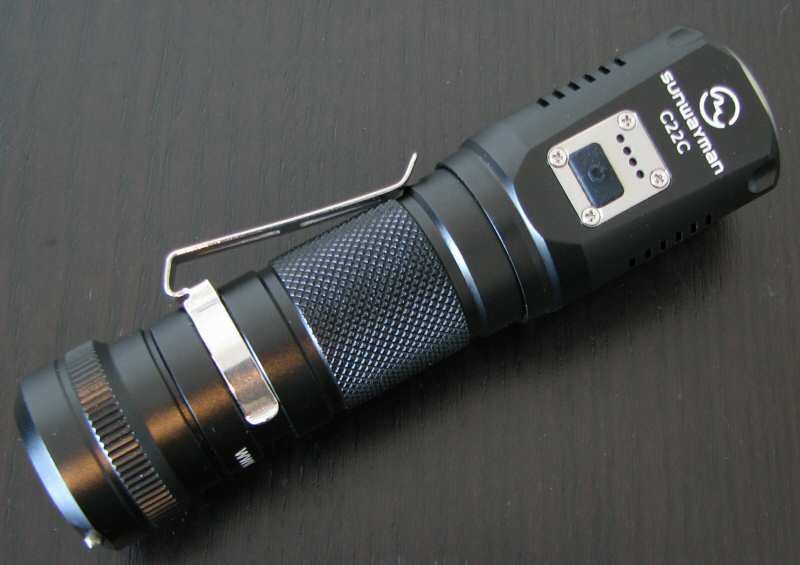
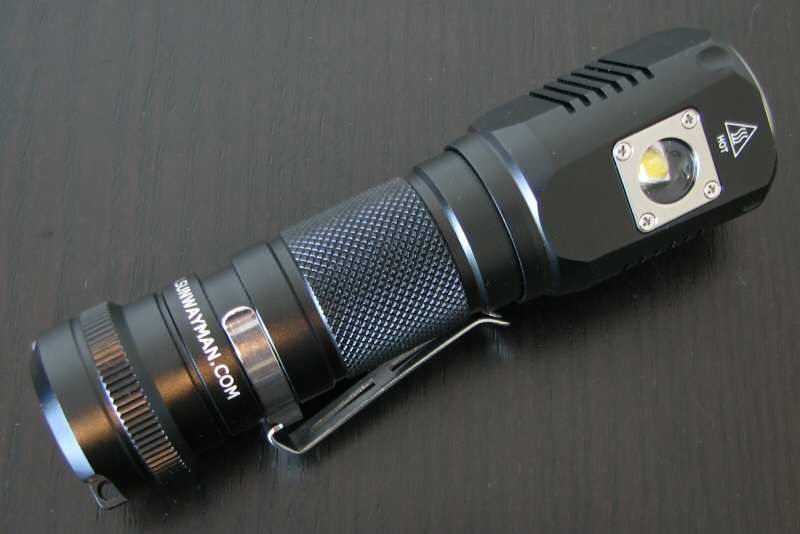
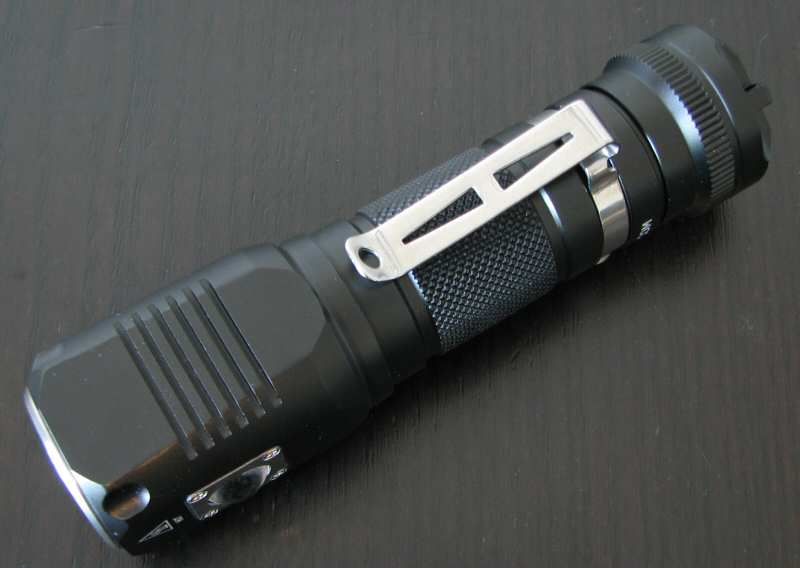
P25C:
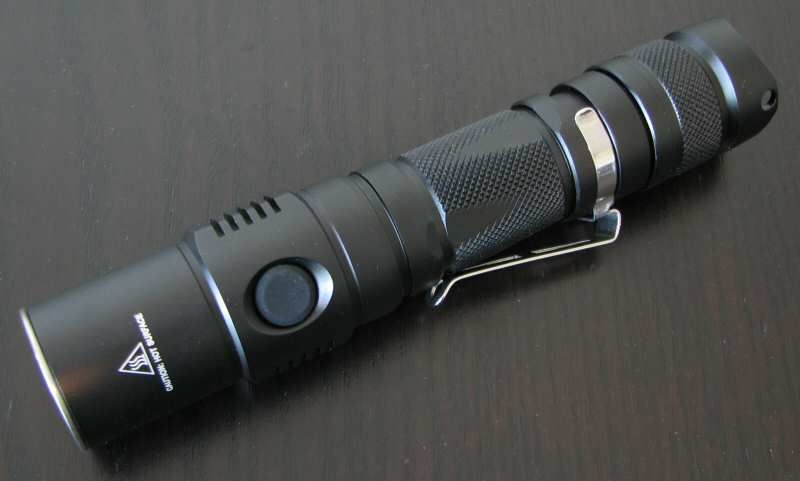
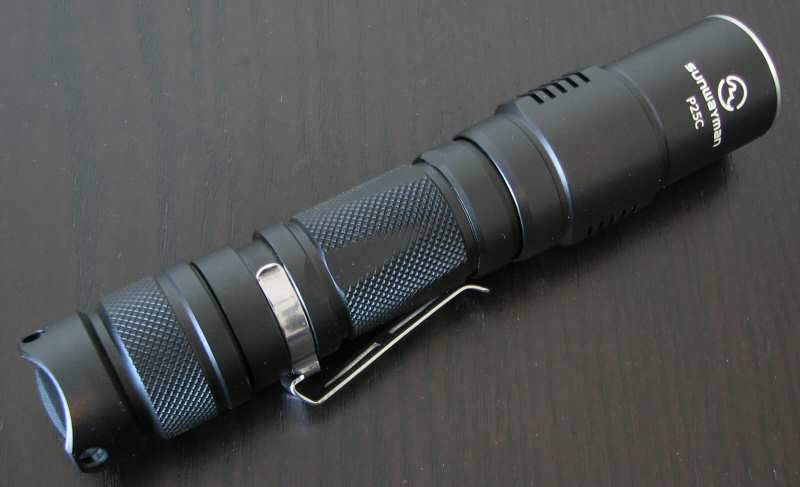
Let's see how they compare. :wave:
Manufacturer Reported Specifications:
(note: as always, these are simply what the manufacturer provides – scroll down to see my actual testing results).
C22C Specs:
C22C
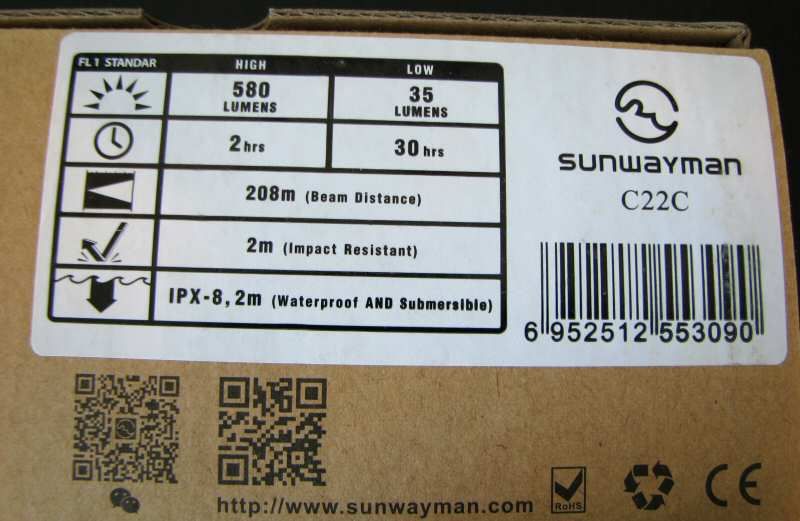
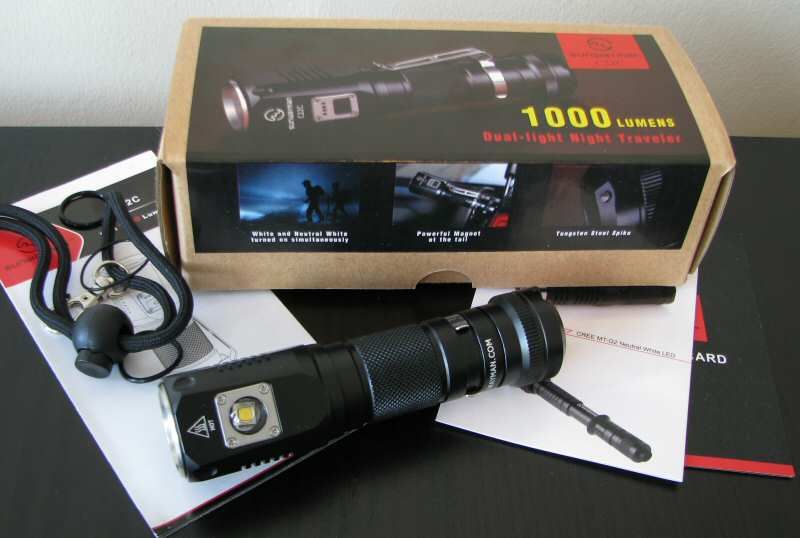
P25C

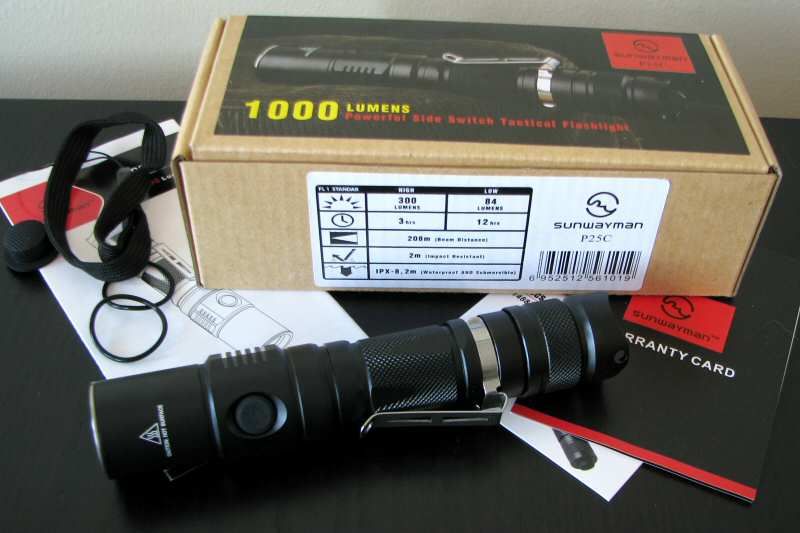
Packaging across the models is the same - Sunwayman's standard cardboard display box, with specs and information printed right on the box. Included with each of the lights are a pocket clip, wrist lanyard, spare O-rings, and manual.
C22C:
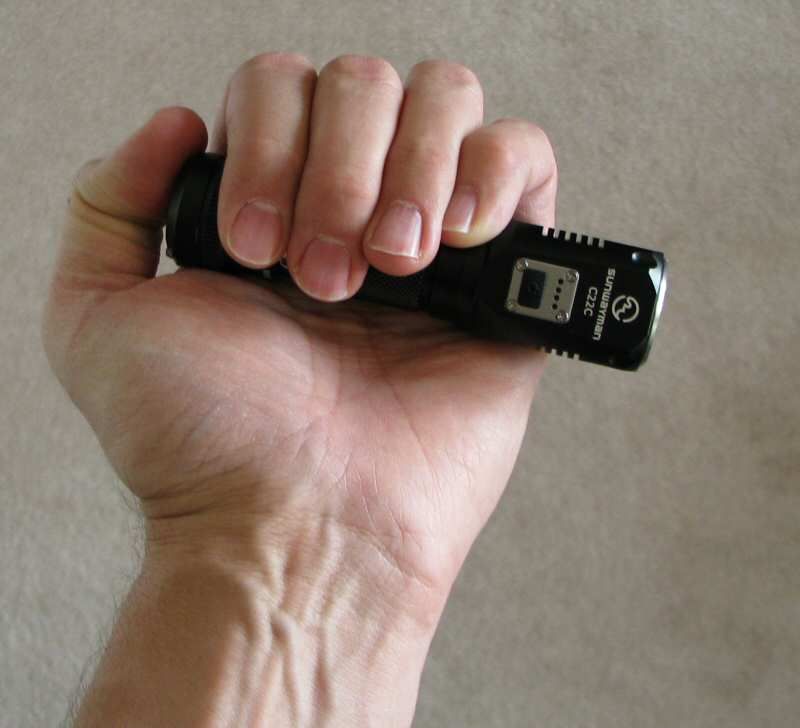
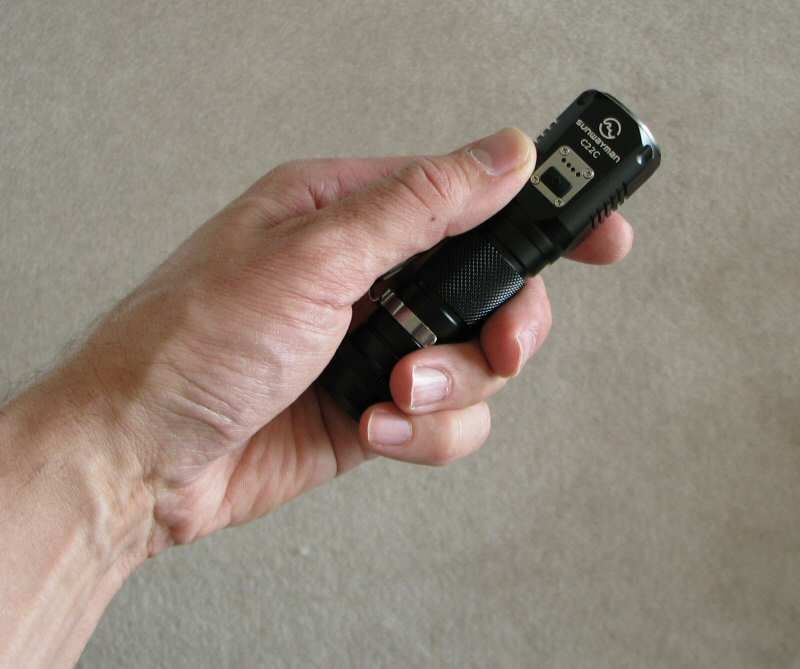
P25C:
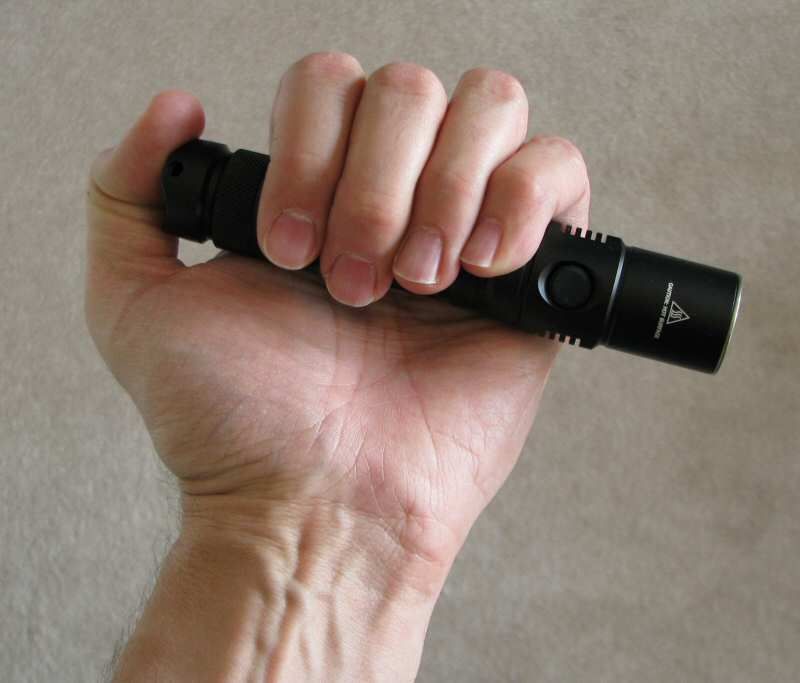
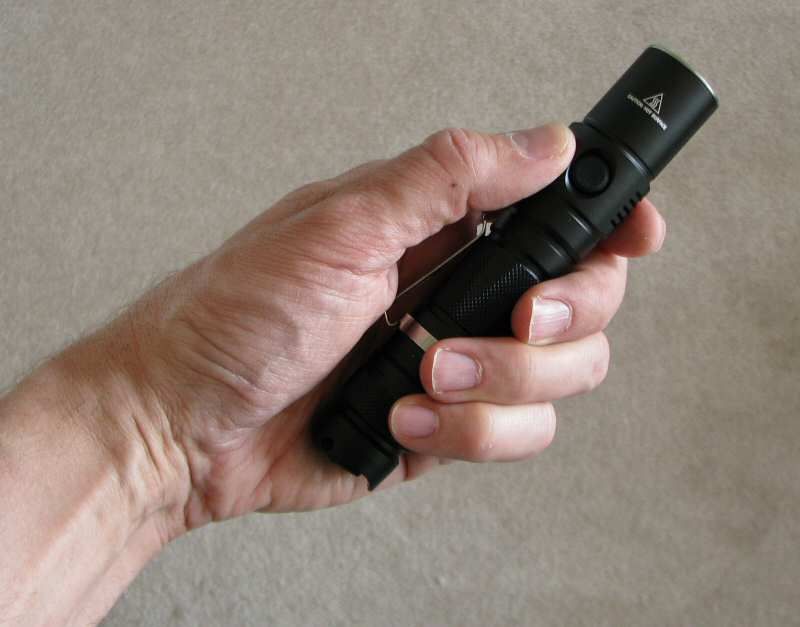
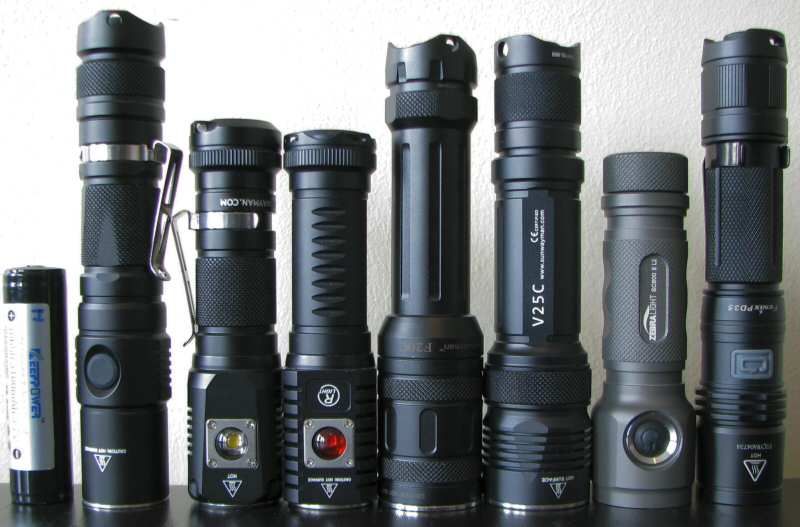
From left to right: Keeppower Protected 18650 3100mAh; Sunwayman P25C, C22C, C21C, F40C, V25C; Zebralight SC600-II, Fenix PD35.
All dimensions directly measured, and given with no batteries installed:
Sunwayman C22C: Weight 88.2g, Length: 110.5mm, Width (bezel side) 26.9mm (bezel diagonal) 31.8mm
Sunwayman P25C: Weight 89.7g, Length: 141.0mm, Width (bezel) 25.5mm
Sunwayman C21C: Weight 78.6g, Length: 102.0mm, Width (bezel side) 26.9mm (bezel diagonal) 31.2mm
Eagletac D25LC2: Weight: 50.0g, Length: 116.3mm, Width (bezel): 22.5mm
Eagletac TX25C2: Weight 93.6g, Length: 120.4mm, Width (bezel): 31.6mm
Fenix PD35: Weight: 82.7g, Length: 138.1mm, Width (bezel): 25.4mm
Nitecore EC20: Weight: 77.1g, Length: 129.2mm, Width (bezel): 25.4mm
Nitecore MH20: Weight: 85.4g, Length: 105.5mm, Width (bezel): 31.8mm
Nitecore P10: Weight 82.0g, Length: 135.1mm, Width (bezel): 25.5mm
Nitecore P12: Weight: 89.7g, Length: 139.4mm, Width (bezel): 25.4mm
Olight S20 (2013, XM-L2): Weight: 52.4g, Length: 106.5mm, Width (bezel): 23.1mm
Skilhunt DS20: Weight: 53.8g, Length: 110.0mm, Width (bezel): 24.0mm
Thrunite TN12-2014: Weight: 80.0g, Length: 140.5mm, Width (bezel): 25.4mm
Zebralight SC600 II: Weight 79.3g, Length: 101.8mm, Width (bezel) 29.7mm
C22C:
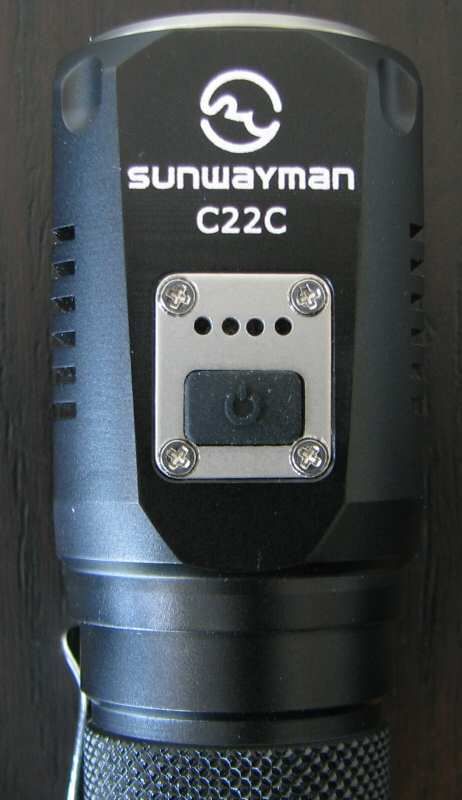
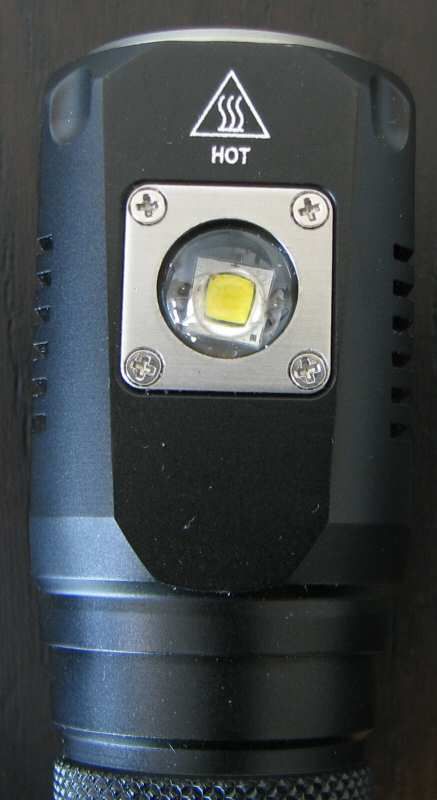
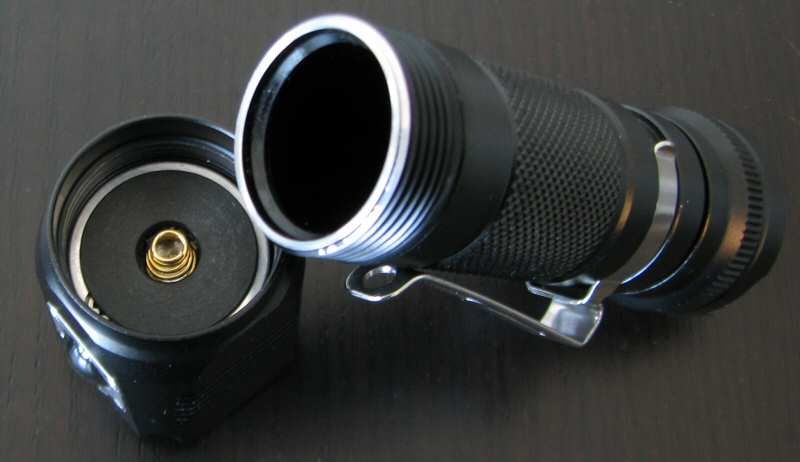
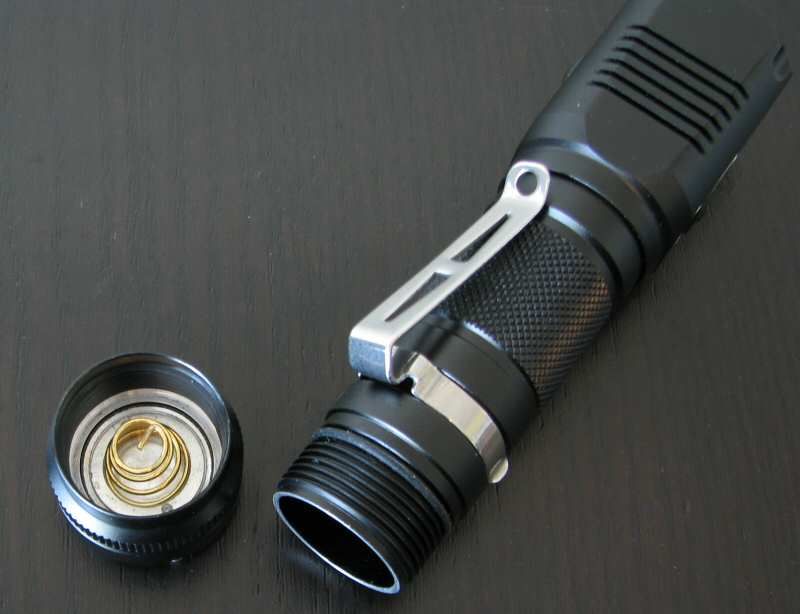
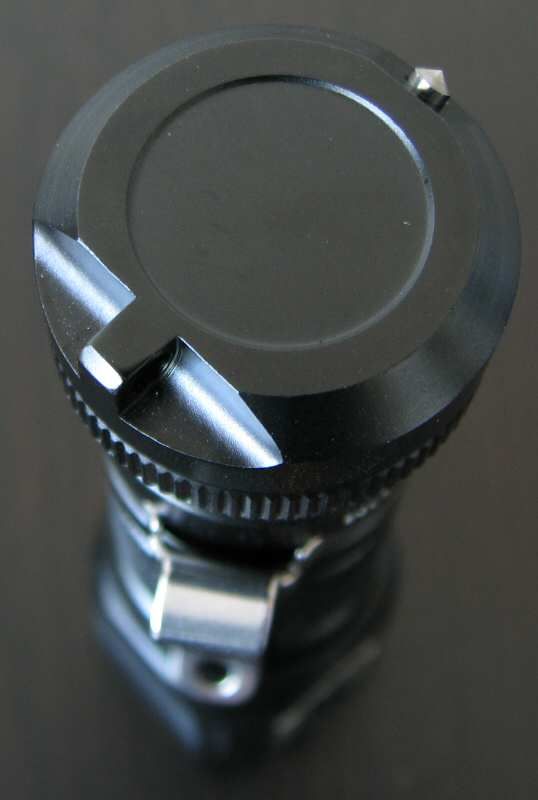
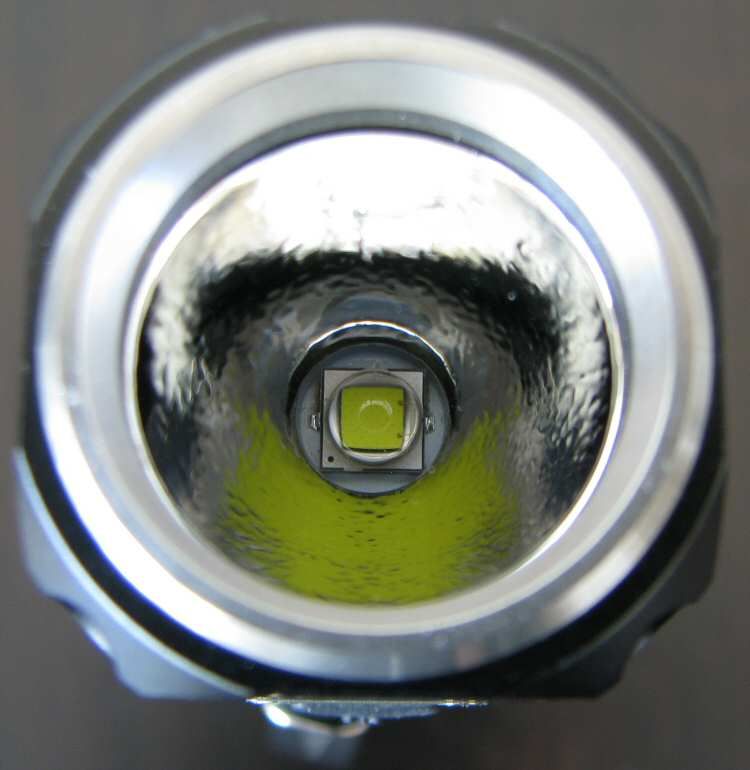
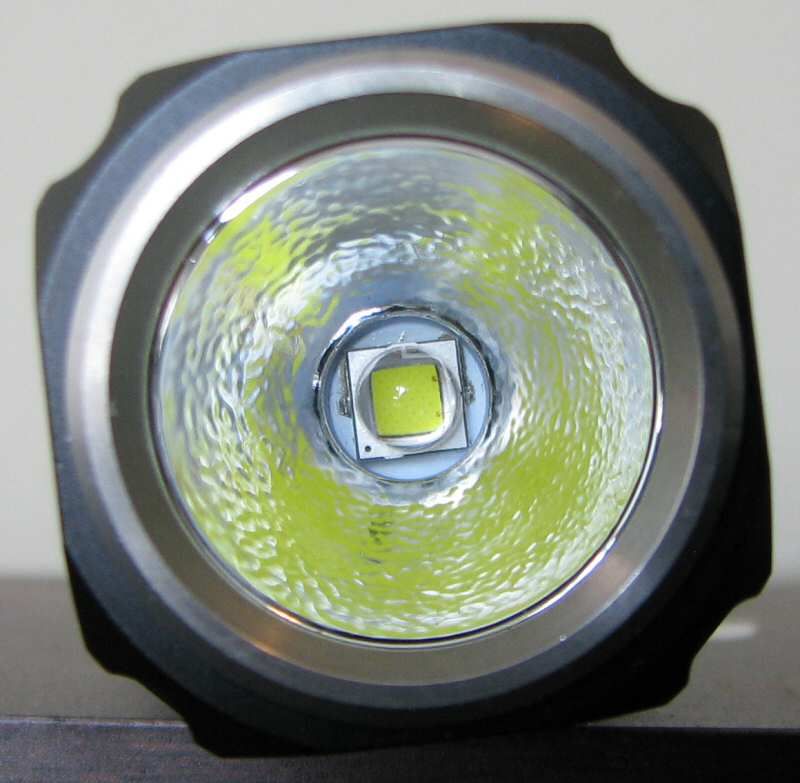
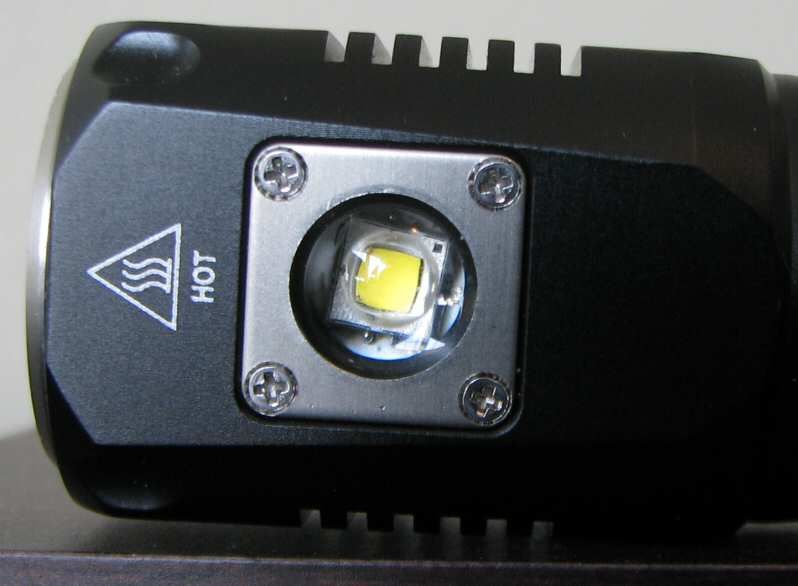
The C22C is very similar in general design to the earlier C21C, but with a neutral white XP-G2 side emitter (flood). Body styling has been updated, but otherwise you can see my comments in that earlier review for build details. A couple of new features - there is a now a magnet in the tailcap (to allow horizontal standing off a metal surface). There is also a small, sharp protruding stainless steel point (which I presume is to break glass, if necessary).
Scroll down for more information on the user interface.
P25C:
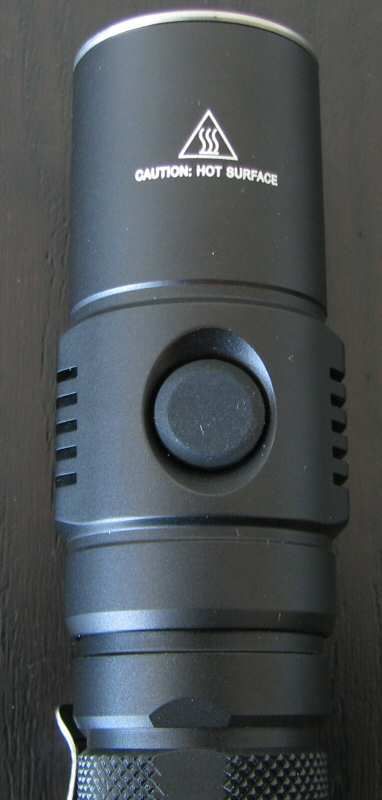
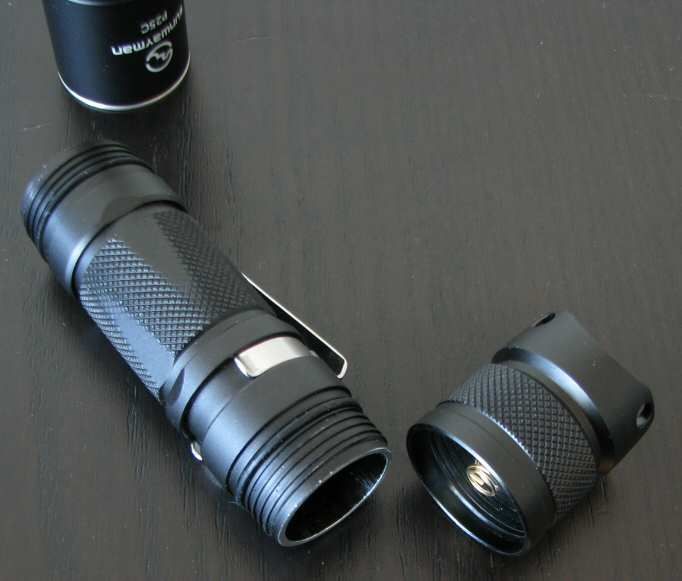
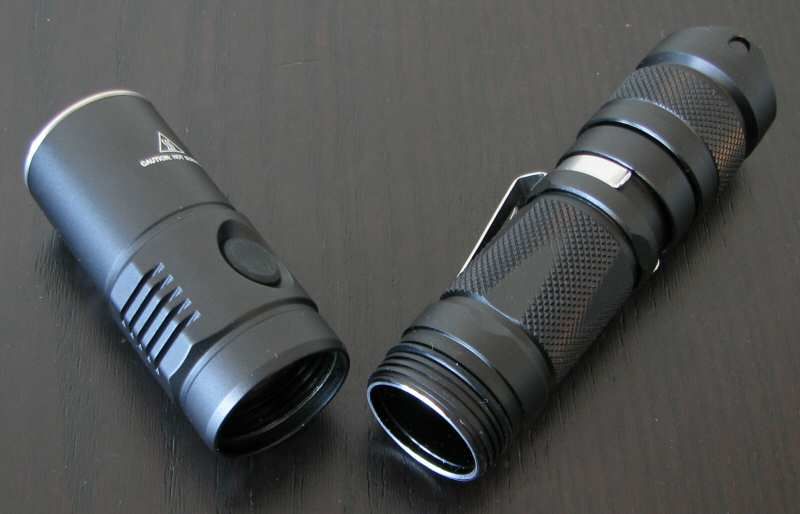
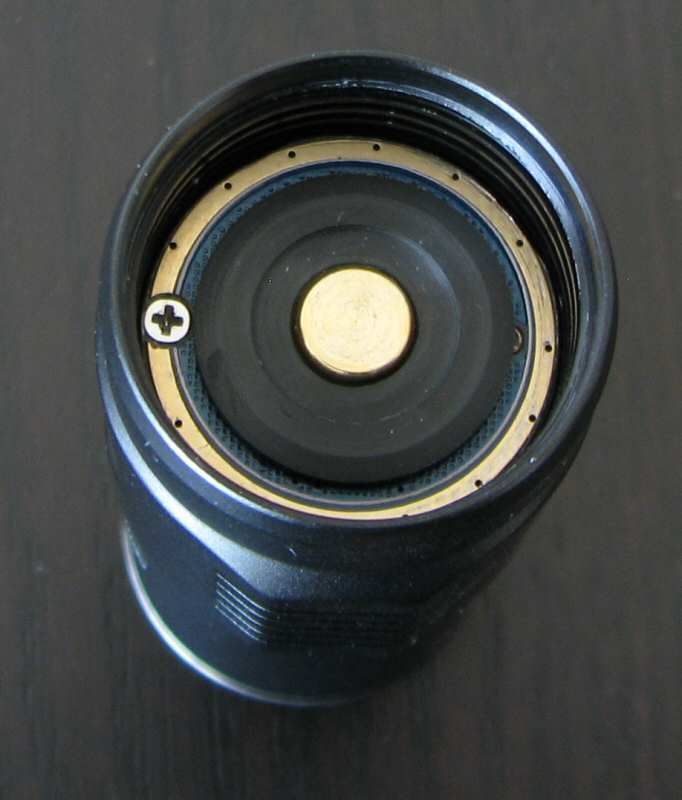
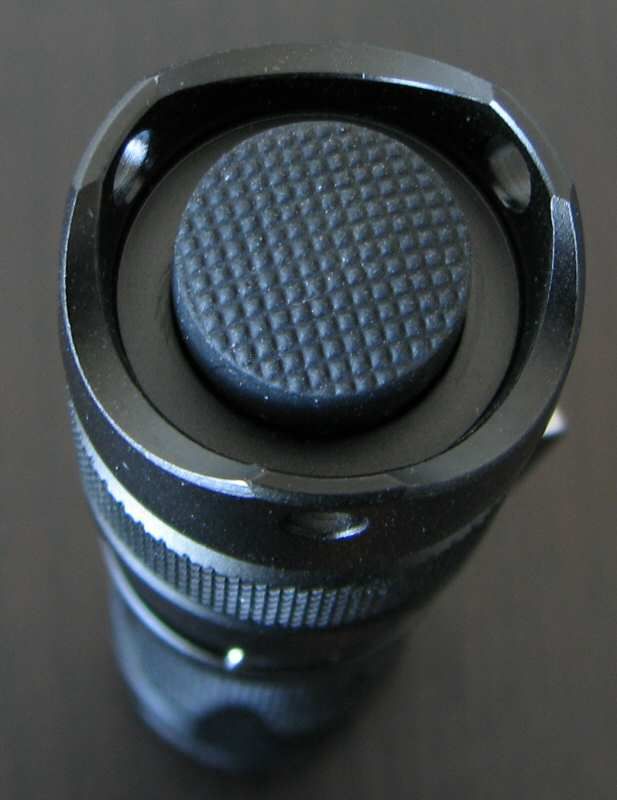
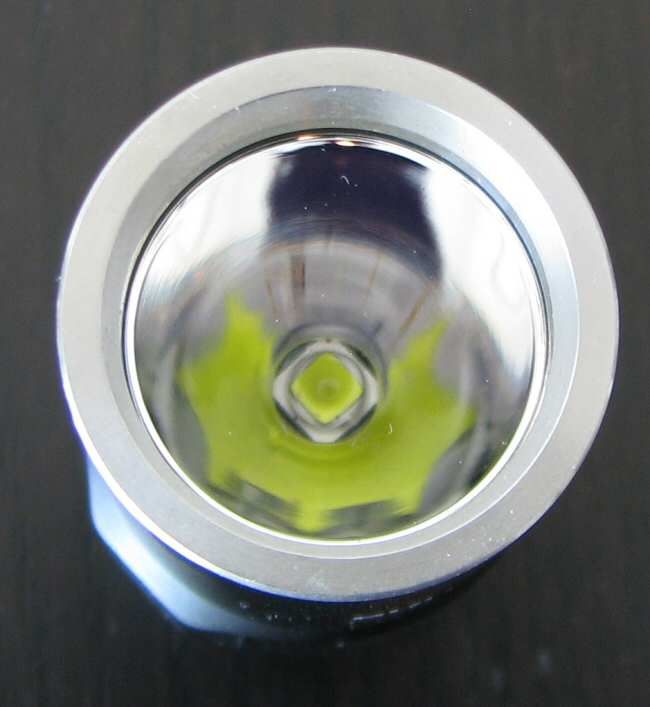
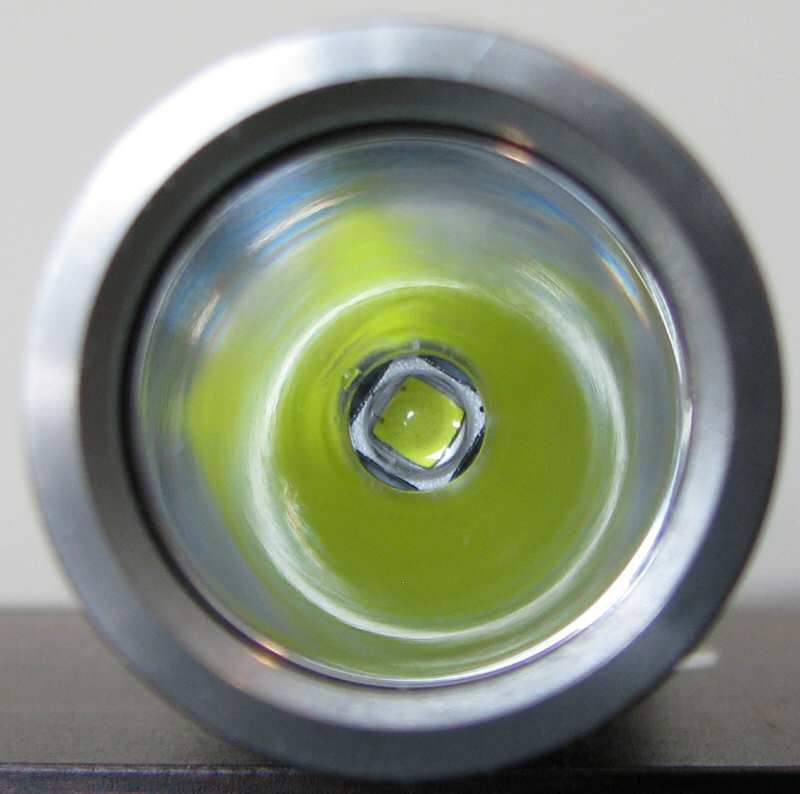
The P25C is similar in general style to a number dual-switch design lights in this class (e.g., Thrunite TN12, Nitecore P12, Fenix PD35, etc.). You have a physical clicky switch for on/off, and side electronic switch (in the head) for mode control.
Both models come with black anodizing – which no imperfections or chips on my samples. The P25C seems a touch less black than the C22C (i.e., more of a really dark natural finish). Lettering is fine and bright white on both models. Knurling is of moderate aggressiveness.
Screw threads are anodized on both models for lock-out (square cut on the P25C, triangular cut on the C22C). Both lights can tailstand.
For more information on the builds, please see my video overview below.
User Interface
C22C
Turn the main cool white beam on by clicking the electronic switch (i.e. a quick press and release, from off). Click again to turn the light off. Turn the neutral white side flood light on by pressing and holding the switch (from off). Again click to turn off.
There are four main output levels of main cool white beam, selected by pressing and holding the switch when on. The light will advance through all the levels in the following repeating sequence: Turbo > Hi > Med > Lo.
For the side flood light, you similarly press and the hold the switch again (after turning the side light on) to change levels. The level sequence is Hi > Med > Lo, in a repeating loop.
The C22C has level memory, but only for the current mode. So for example, if you turn the light off in the main cool white Lo mode, and then re-active (in cool white), you will get Lo again. But if you re-activate in side neutral light, the main cool white level memory is erased and the new side level is saved upon turning off the light. :shrug: Note also that the default level is max output, for either mode (i.e., when you switch to the other emitter, it first activates in max).
Double-click from on (in either cool white or neutral white modes) to activate Strobe. Double-click again to advance to SOS. A single click returns you to constant on.
To activate both emitters simultaneously, from On or Off, do a quick click followed immediately by a press-hold. After 1 sec, the light will turn on both emitter emitters in a relative Hi mode. This a single-mode only, there are no additional levels. A single click turns the light off.
As this is an electronic switch, a standby current is required (see below for measurements). There is no lock-out option on the C22C that I am aware of.
P25C
The P25C uses a dual-switch interface, similar to the Fenix PD35, Thrunite TN12 and Nitecore P12.
Turn the light on/off by the forward tailcap switch. Lightly press and hold for momentary, click (press and release) for constant on. Click again to turn off.
To change modes, click the electronic switch in the head, while the light on. Mode sequence is Lo > Med > Hi > Turbo, in repeating sequence. The light has mode memory, and returns the last level set after turning the tail switch off/on.
Press and hold the side electronic switch to access strobe modes. Press and hold repeatedly to cycle through strobe modes. Mode sequence is Strobe > SOS > Beacon, in a repeating loop. A single click exits you from strobes back into constant output.
Video:
For more information on the lights, including the build and user interfaces, please see my video overview:
As with all my videos, I recommend you have annotations turned on. I commonly update the commentary with additional information or clarifications before publicly releasing the video.
PWM/Strobe
Most Sunwayman lights don't use pulse width modulation (PWM) to control the lower output modes. However, I did previously detect measurable circuit noise on my C21C – although not visible to the eye. A similar pattern was noted on the C22C, but only on the side neutral white emitter
C22C NW Med
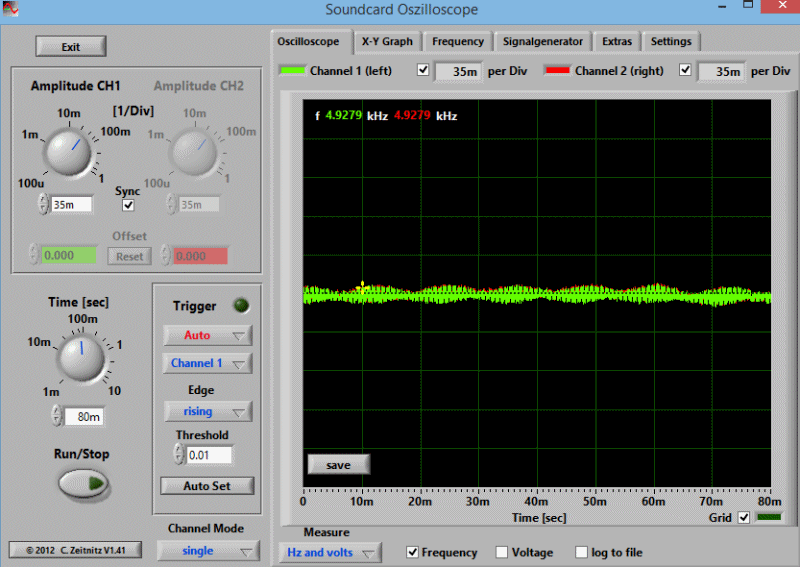
C22C NW Lo
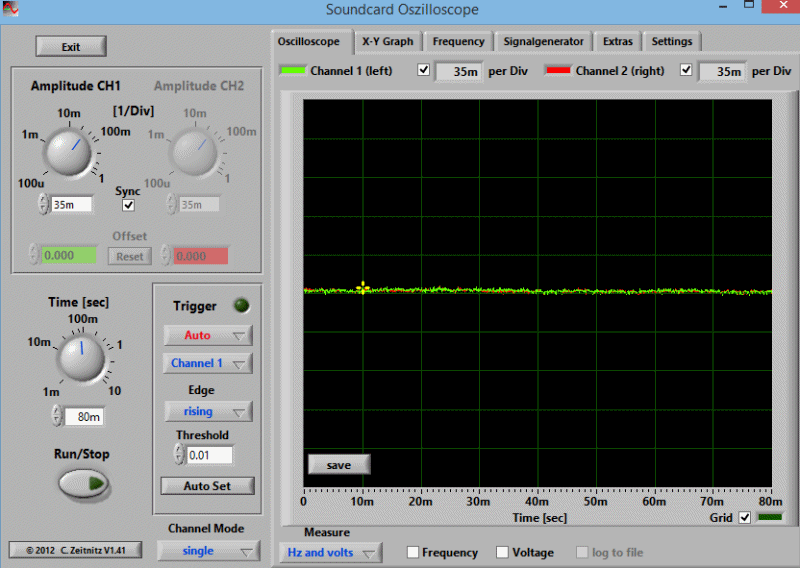
Again, these signals are extremely high-frequency, and cannot be seen in practice. Rest assured the C22C is fully "flicker-free" in all modes. :thumbsup: As per my standard review policy, I simply report on anything I can measure (whether it is visually detectable or not).
The P25C is a different case, where there does seem to be visible PWM-like effects on the sub-max modes.
P25C Turbo
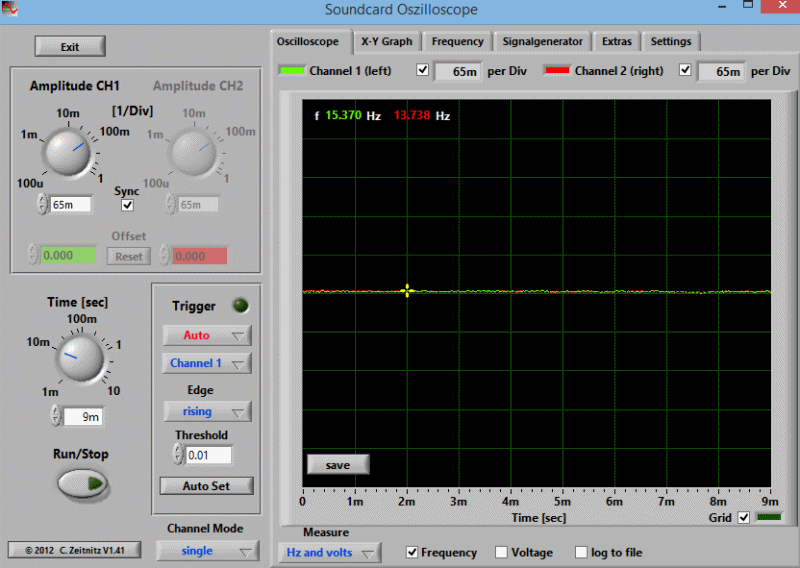
P25C Hi
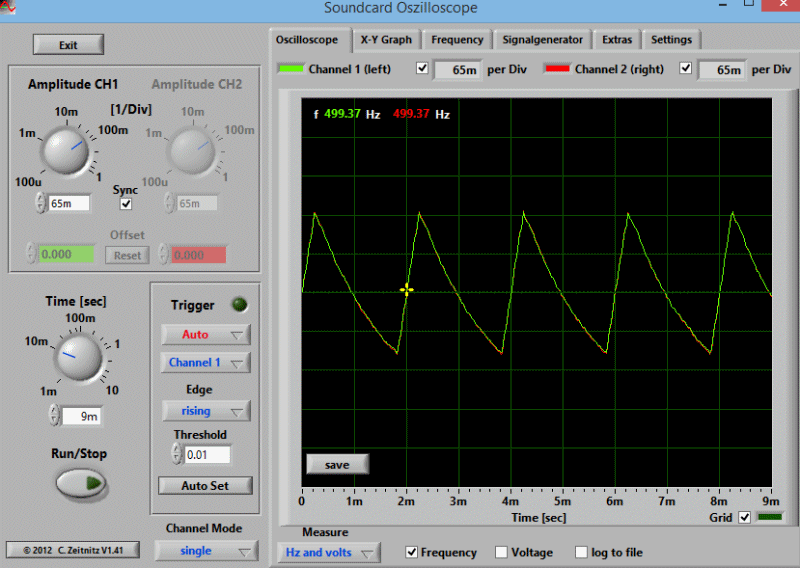
P25C Med
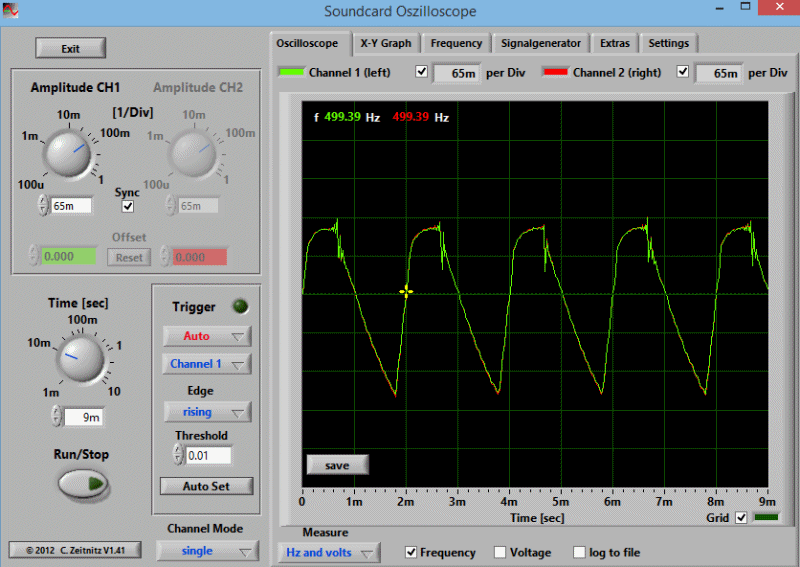
P25C Lo
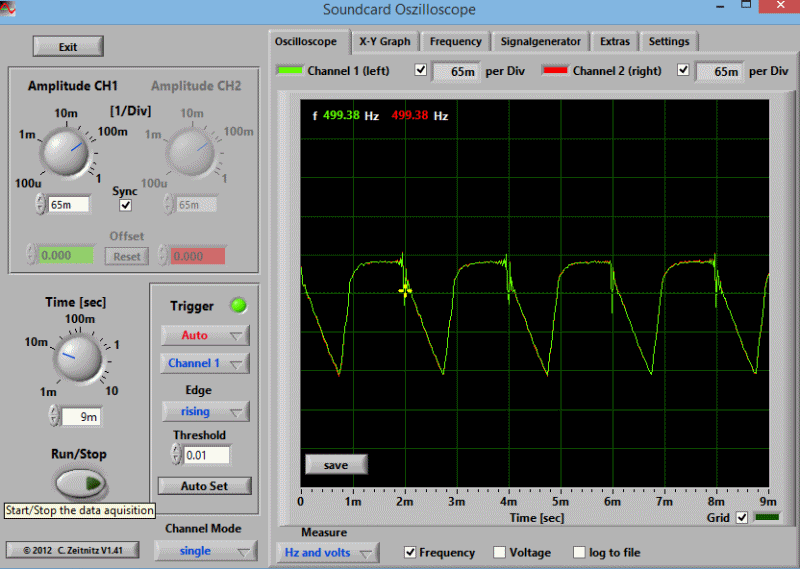
This pattern is a little unusual, and doesn't have the typical PWM square pulse-wave. Nonetheless, the pulse width is modulated with perceived output level, suggesting this is indeed PWM control. It is also visible by eye, given the ~500 Hz frequency. Personally, I only found it noticeable in practice on Lo and Med, but would have preferred not to have seen it all. :sigh:
EDIT: Sunwayman confirms that smoothing is applied to the PWM signal - presumably to make it less visually detectable. It seems to be working, as I didn't find the PWM to be as noticeable as typical 500 Hz PWM - but I can indeed still detect it visually.
C22C CW Strobe
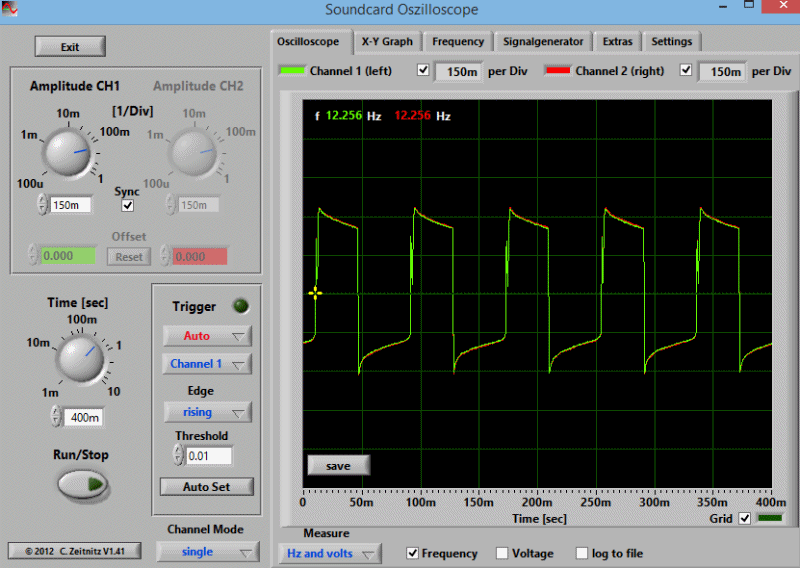
C22C NW Strobe
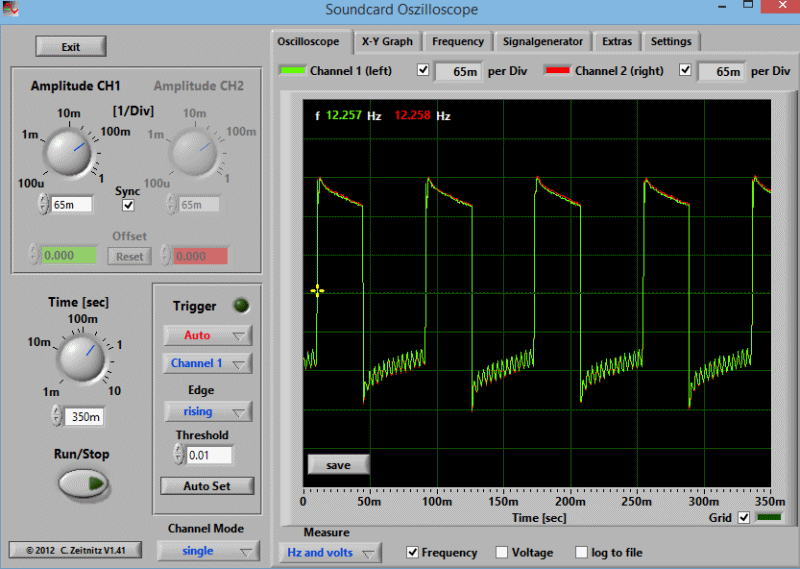
Both the main cool white and side neutral white emitters strobe at a frequency of ~12.3 Hz.
P25C Strobe
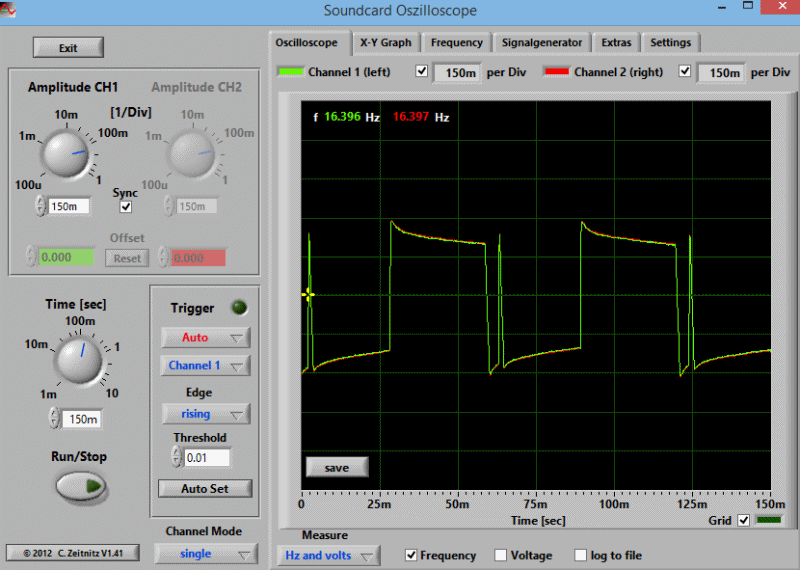
The P25C has a fairly high frequency strobe, at 16.4 Hz.
P25C SOS
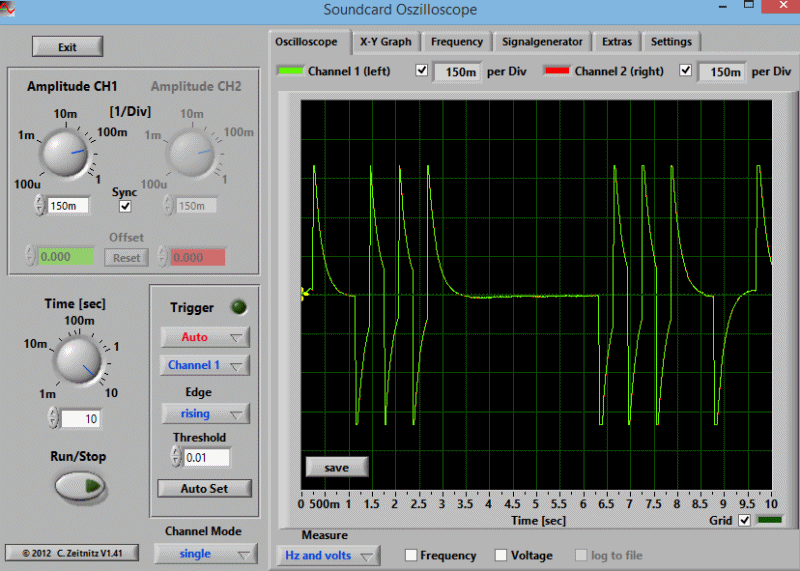
P25C SOS mode is fairly typical. I haven't bother to show the beacon mode, but it is a quick flash every 2 secs.
Standby Drain
As the switch on C22C is an electronic one, a standby current drain is always present when a battery is installed. There is no standby drain on the P25C, due to the physical clicky switch.
When I first connect an 18650 with my DMM, I measured an initial current of ~1580uA. However, after a few seconds, the stand-by drain dropped to 9.4uA, and remained there stably. This is very similar to the C21C. It would translate into 37 years before a 3100mAh battery would be drained. It is definitely negligible, and not a concern.
Unlike the C21C though, I don't see an electronic lock-out on the C22C. You can also physically lock-out the C22C by a twist of the tailcap (thanks to the anodized threads).
Beamshots:
For white-wall beamshots below, all lights are on Max output on an AW protected 18650 battery. Lights are about ~0.75 meter from a white wall (with the camera ~1.25 meters back from the wall). Automatic white balance on the camera, to minimize tint differences.
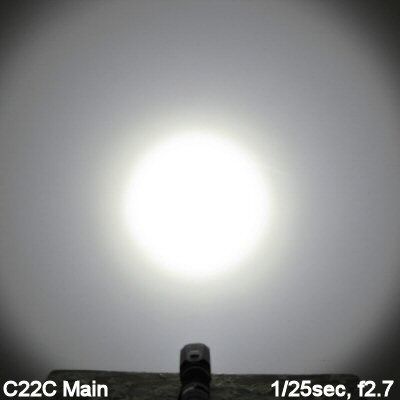
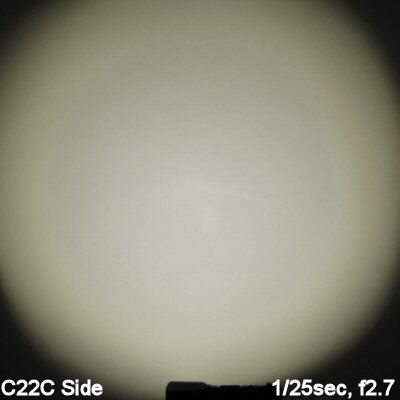
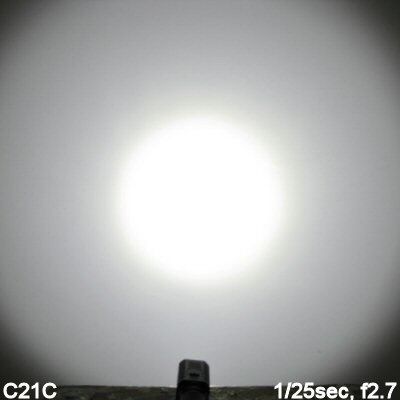
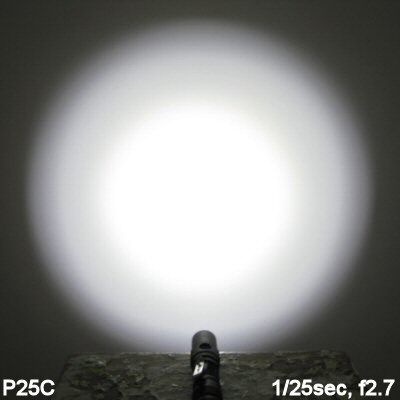
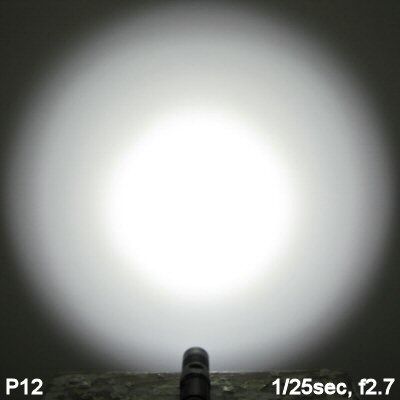
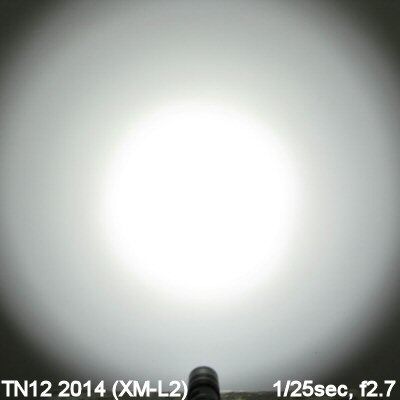
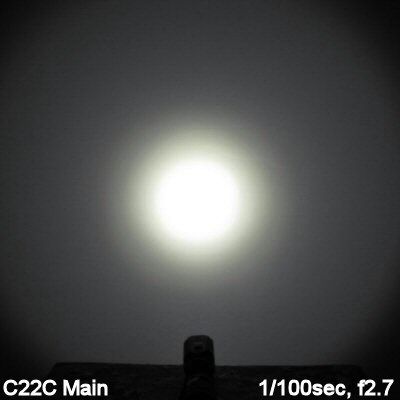
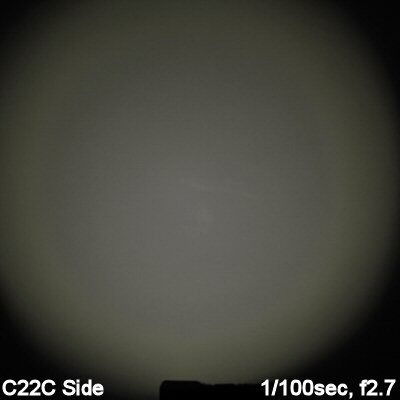
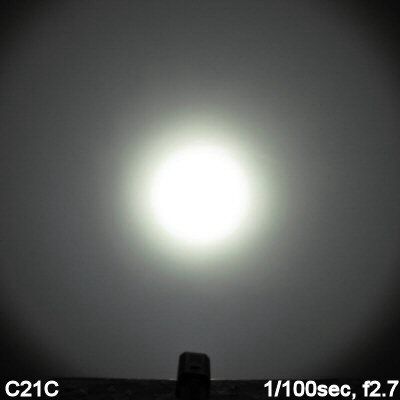
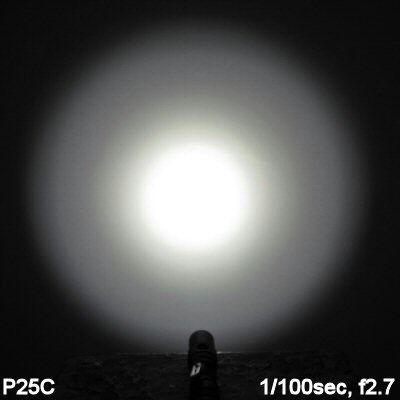
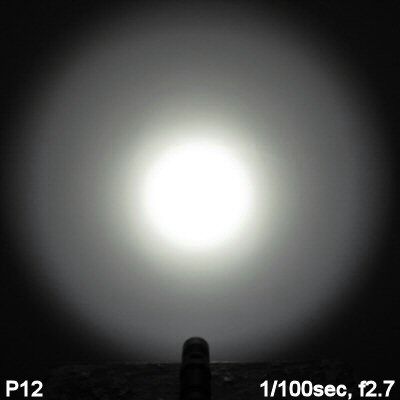
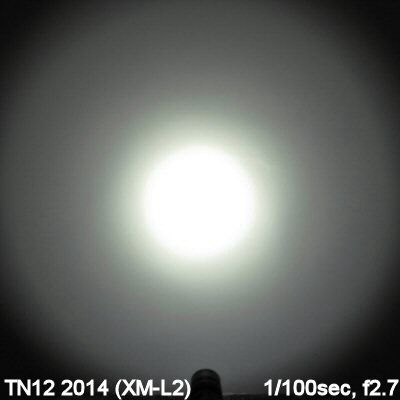
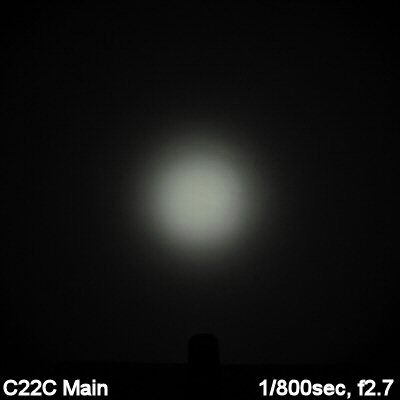
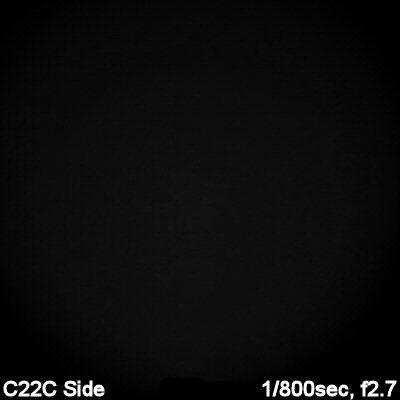
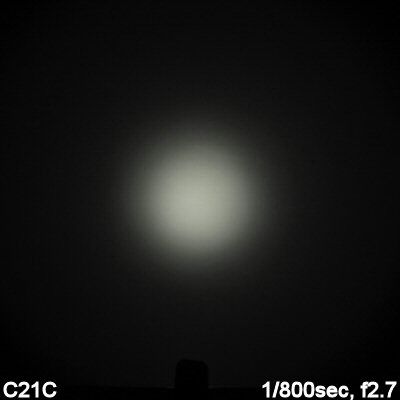
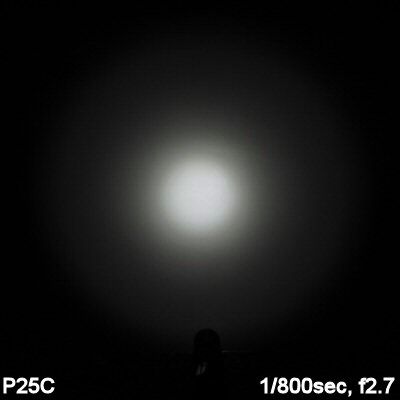
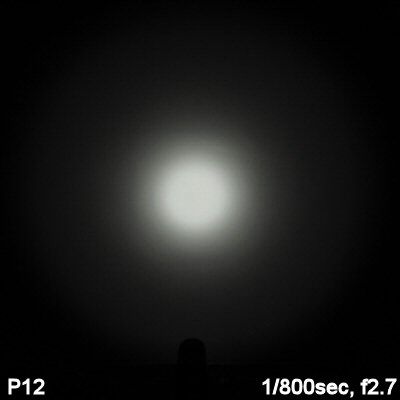
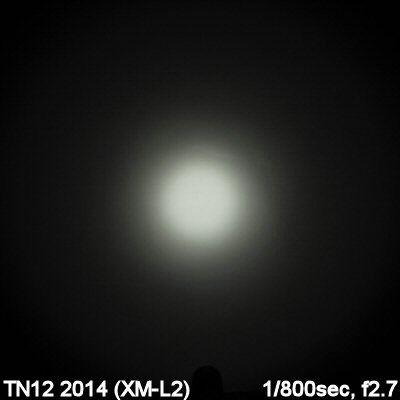
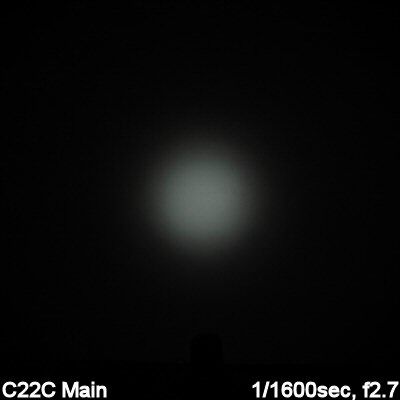
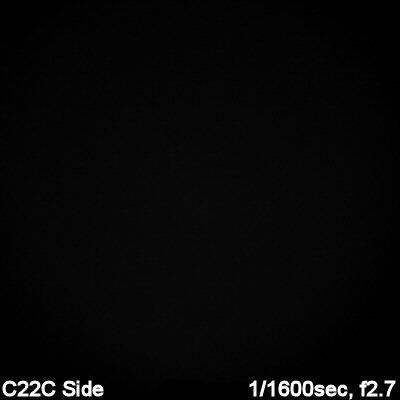
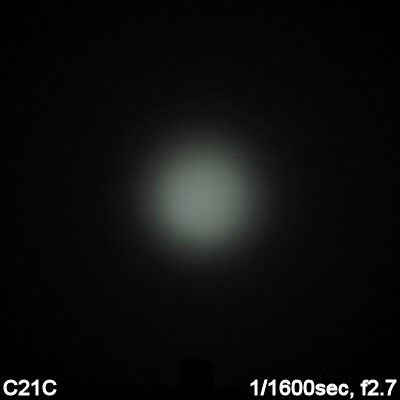
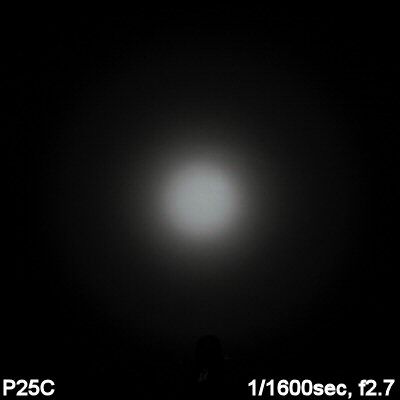
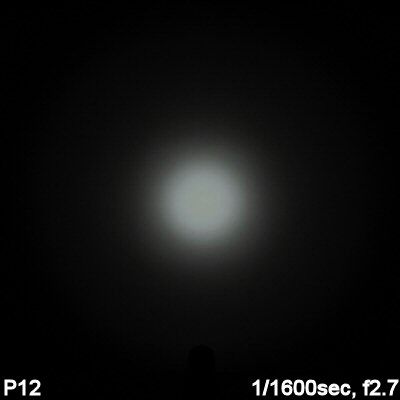
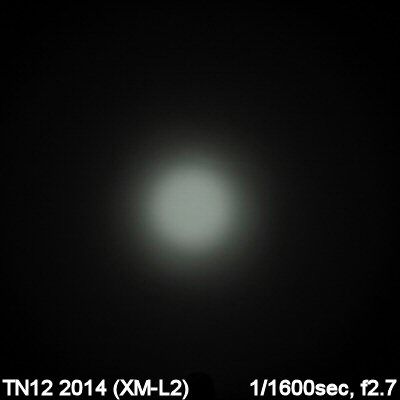
Testing Method:
All my output numbers are relative for my home-made light box setup, as described on my flashlightreviews.ca website. You can directly compare all my relative output values from different reviews - i.e. an output value of "10" in one graph is the same as "10" in another. All runtimes are done under a cooling fan, except for any extended run Lo/Min modes (i.e. >12 hours) which are done without cooling.
I have devised a method for converting my lightbox relative output values (ROV) to estimated Lumens. See my How to convert Selfbuilt's Lightbox values to Lumens thread for more info.
Throw/Output Summary Chart:
My summary tables are reported in a manner consistent with the ANSI FL-1 standard for flashlight testing. Please see http://www.flashlightreviews.ca/FL1.htm for a discussion, and a description of all the terms used in these tables. Effective July 2012, I have updated all my Peak Intensity/Beam Distance measures with a NIST-certified Extech EA31 lightmeter (orange highlights).
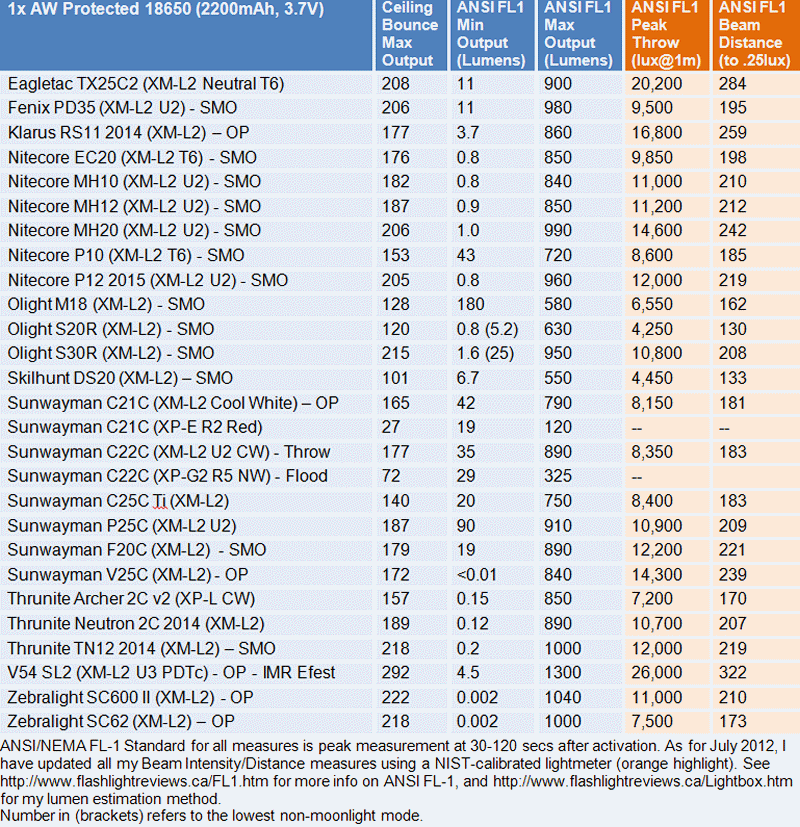
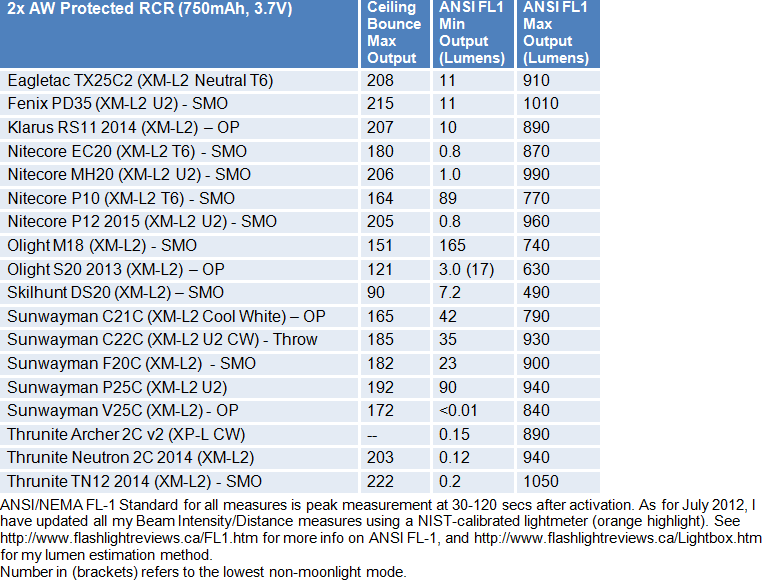
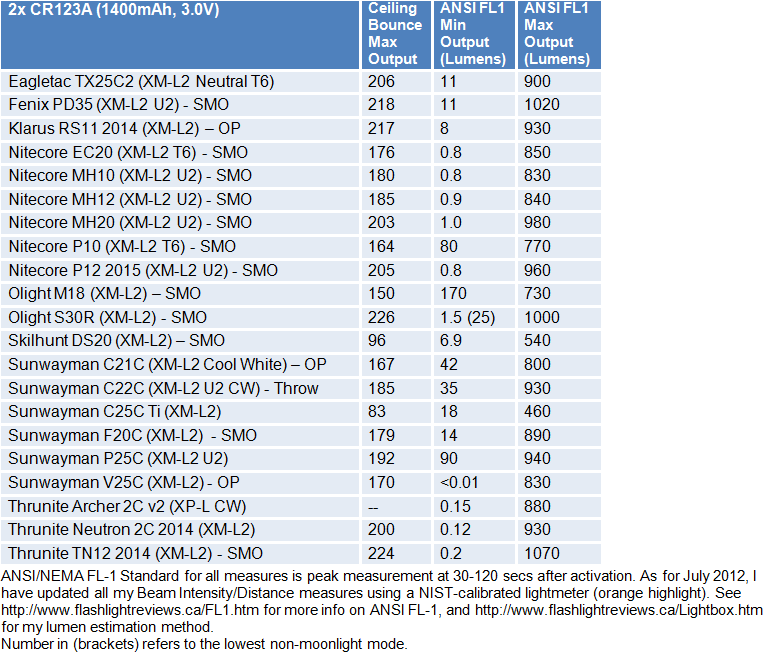
Max output is reasonable on both the C22C and P25C, but I would have liked to have seen lower Lo modes included on both models.
Note that while 2xRCR are not official supported, I did test them in both lights. I will not be doing runtimes, however.
Let's see how all the levels compare across the lights on 1x18650, in my lightbox:
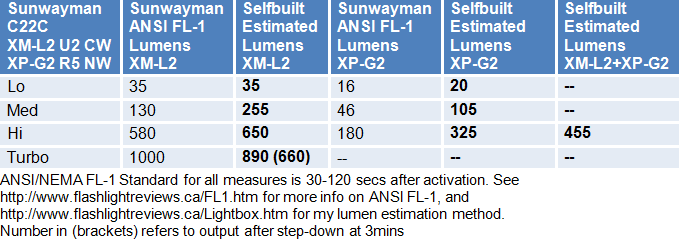
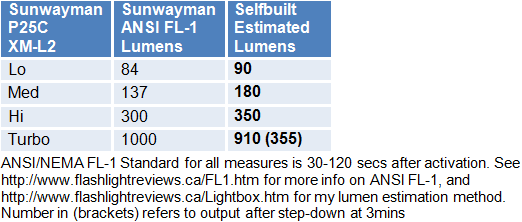
Output/Runtime Graphs:
All my current runtimes are done with protected NCR18650A (3100mAh capacity) batteries. First, a comparison between these two lights:
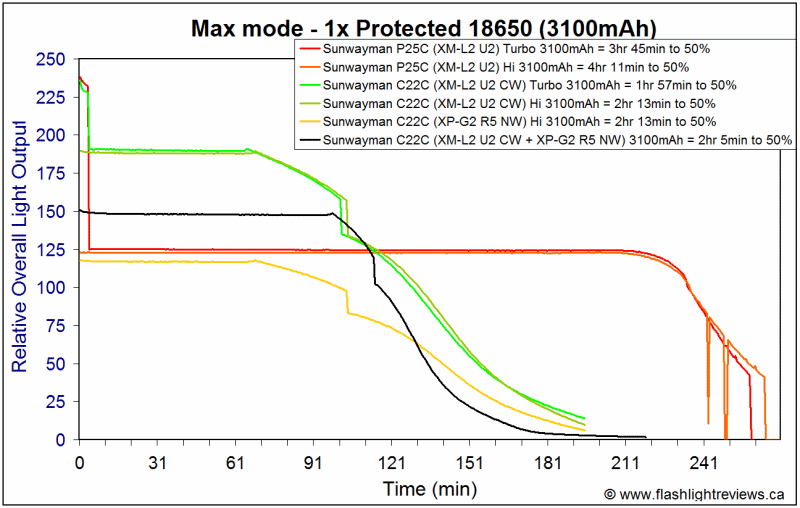
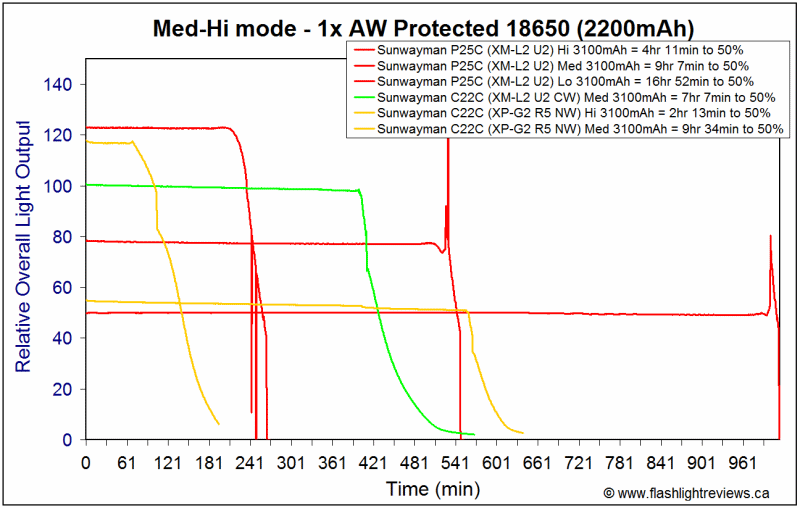
Basically, both lights step down from their max level to Hi after 3 mins of runtime – but the P25C Hi level is much lower than the C22C.
The combined emitter output mode of the C2CC is intermediate in overall output to the individual max modes of the emitters singly (as you might expect).
And now how they compare to other lights on 1x18650:
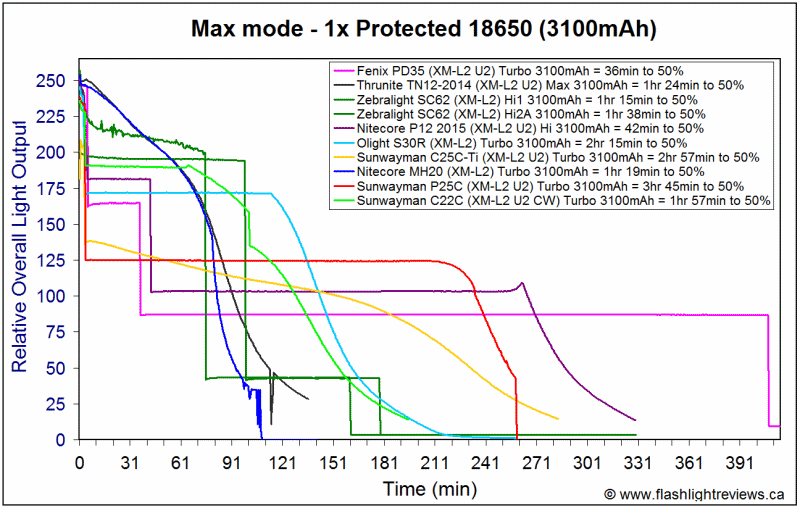
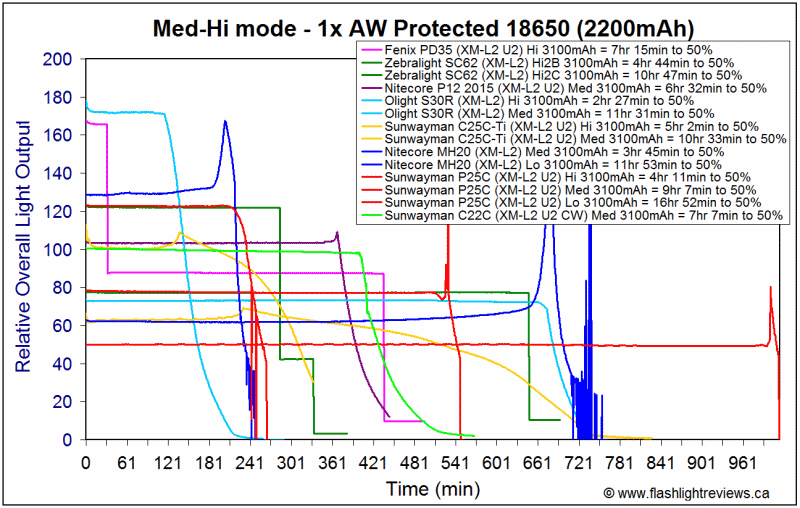
And now runtimes on 2xCR123A
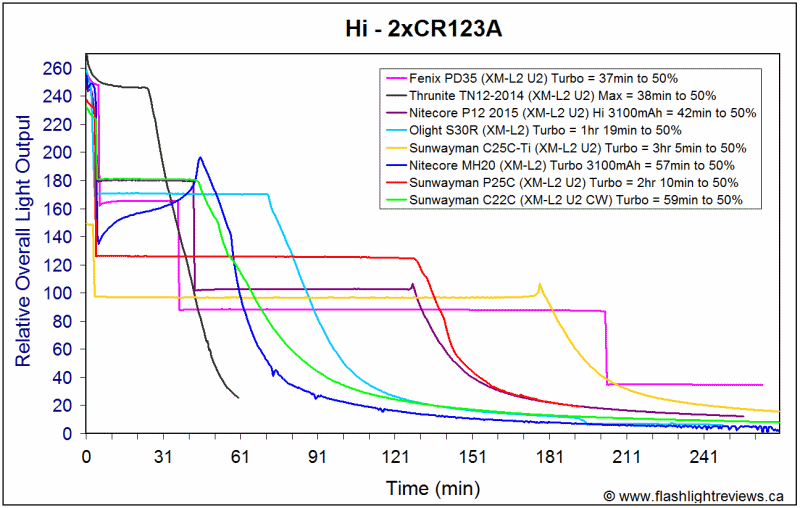
Overall output/runtime efficiency is in keeping with other lights in this class.
Potential Issues
The P25C has visible pulse-width-modulation (PWM) on its Lo/Med/Hi modes, at a fairly low ~500Hz frequency. This can produce a visual "flicker" for those who are susceptible to it - although Sunwayman is using smoothing to help make it less visually distracting. Still, I would prefer to see current-control, or invisible high-frequency PWM.
The C22C uses an electronic switch, and therefore has a standby current when connected but not on. However, this current is negligible - and can easily be broken by a simple twist of the anodized tailcap.
The electronic switch on the C22C is smaller than typical, and may be hard to access with gloves on. User interface may take a little getting used as well. Mode memory is not independently maintained for the two emitters modes (i.e., only one common memory store for last mode/output level used).
There are timed step-downs from Turbo on both lights – although the P25C steps down to a lower Hi level than the C22C.
The P25C lacks a true Lo mode, and neither light has anything approaching an ultra-low Lo mode.
Preliminary Observations
Let's start with the C22C. This light is an iterative update to the C21C reviewed previously. Basically, the side-mounted red LED has been replaced with a neutral white LED. Otherwise, not much is different (except for the option to turn on both emitters simultaneously now, at a single Hi level).
Physically, ergonomics and hand feel on the C22C remain decent - although you might find both the light and electronic switch to be a bit small (especially if you have large hands). As before, I find the user interface not entirely intuitive given that all features that need to be controlled by a single switch. Beam patterns are good. Output/runtime performance is very good, consistent with a current-controlled circuit – no surprises here.
The P25C is clearly meant to compete with all the other dual-switch lights out there (i.e., Fenix PD35, Nitecore P12, Thrunite TN12, etc, etc.). Physically, it seems to play in the same ballpark as the others, and the user interface will feel very familiar. Overall, it probably most reminds me of the P12, given its somewhat narrower spillbeam.
Unfortunately, the P25C suffers from visible PWM on its lower modes, at a noticeable 500 Hz. :sigh: I suppose this may not be an issue for those not particularly susceptible to PWM flicker (and the circuit smoothing applied by Sunwayman seems to be somewhat effective in reducing its visual effect overall). But if you are sensitive to it like me, you may want to give this light a pass for this reason. At least the overall efficiency doesn't seem to be overly affected – it still compares reasonably well to the current-controlled competition.
One thing that is disappointing on both models (but especially the P25C) is the lack a true Lo mode. :thinking: Personally, I consider this a minimum requirement on any general purpose light – and would even like to see a firefly/moonlight mode as well.
To wrap up, the C22C is really just a minor update to the C21C model, with a substitution of the side emitter. Not really a compelling reason to upgrade, but it does provide another emitter choice if you are interested in the feature set. The P25C is playing a bit of catch-up in the popular dual physical/electronic switch class – but unfortunately suffers from visible PWM. This is something most of the competing models lack (being fully current-controlled).
Hopefully the detailed testing results above will help you in choosing from among the crowded 1x18650 class. :wave:
----
C22C and P25C provided by Sunwayman for this review.
I have on hand a couple of 1x18650/2xCR123A models from Sunwayman – the C22C and P25C. The C22C replaces the C21C that I reviewed previously , and the P25C is similar to a number of competing lights from other makers.
C22C:



P25C:


Let's see how they compare. :wave:
Manufacturer Reported Specifications:
(note: as always, these are simply what the manufacturer provides – scroll down to see my actual testing results).
C22C Specs:
- LED: CREE XM-L2 (U2) & CREE XP-G2 (R5)
- Battery: 2x CR123A or 1x 18650 (Batteries NOT included)
- Cool White CREE XM-L2 (U2) Main Light - Output mode/Runtime: Turbo: 1000 lumens / *, High: 580 lumens / 2hrs, Mid: 130 lumens / 10hrs, Low: 35 lumens / 30hrs, Strobe: 1000 lumens
- Neutral White CREE XP-G2 (R5) Side Light - Output mode/Runtime: High: 180 lumens / 3hrs, Mid: 46 lumens / 9hrs, Low: 16 lumens / 45hrs
- Max Beam Distance: 208 meters
- Cool white main light and neutral side light
- Tactical forward click switch for momentary On
- Constant current circuit provides constant output
- Tungsten steel spike defense tool
- Toughened ultra-clear mineral glass with anti-scratch coating
- Constructed from aero-grade aluminum alloy
- HAIII military grade hard-anodized finish
- Impact resistant to 1.5 meters
- Waterproof in accordance with IPX-8 standards
- Included Accessories: pocket clip, lanyard, and spare O-rings
- Dimensions: Length: 4.3" (110mm), Bezel Diameter: 1.1" (28mm), Body Diameter: 0.98" (25mm)
- Weight: 3.1 oz (88g) (excluding batteries)
- MSRP: ~$57
- LED: CREE XM-L2 U2
- Runs on: 1x 18650 or 2x CR123A (Batteries NOT included)
- Output mode/Runtime: Turbo: 1,000 lumens, High: 300 lumens / 3hrs
Mid: 137 lumens / 7.5hrs, Low: 84 lumens / 12hrs, Strobe: 1,000 lumens / hrs - Max Beam Distance: 208 meters
- Dual switch design provides simple single-hand operation
- Smart low-voltage function
- Intelligent mode memory
- Constant current circuit provides constant output
- Rolling-resistant knurling enhances the heat sink capability
- Toughened ultra-clear mineral glass with anti-scratch coating
- Constructed from aero grade aluminum alloy
- HA III military grade hard-anodized finish
- Impact resistant to 1.5 meters
- Waterproof in accordance with IPX-8 standards
- Included Accessories: pocket clip, lanyard, and spare O-rings
- Dimensions: Length: 5.55" (141mm), Bezel Diameter: 1" (25.4mm), Body Diameter: 1" (25.4mm)
- Weight: 3.17 oz (90g) (excluding batteries)
- MSRP: ~$48
C22C


P25C


Packaging across the models is the same - Sunwayman's standard cardboard display box, with specs and information printed right on the box. Included with each of the lights are a pocket clip, wrist lanyard, spare O-rings, and manual.
C22C:


P25C:



From left to right: Keeppower Protected 18650 3100mAh; Sunwayman P25C, C22C, C21C, F40C, V25C; Zebralight SC600-II, Fenix PD35.
All dimensions directly measured, and given with no batteries installed:
Sunwayman C22C: Weight 88.2g, Length: 110.5mm, Width (bezel side) 26.9mm (bezel diagonal) 31.8mm
Sunwayman P25C: Weight 89.7g, Length: 141.0mm, Width (bezel) 25.5mm
Sunwayman C21C: Weight 78.6g, Length: 102.0mm, Width (bezel side) 26.9mm (bezel diagonal) 31.2mm
Eagletac D25LC2: Weight: 50.0g, Length: 116.3mm, Width (bezel): 22.5mm
Eagletac TX25C2: Weight 93.6g, Length: 120.4mm, Width (bezel): 31.6mm
Fenix PD35: Weight: 82.7g, Length: 138.1mm, Width (bezel): 25.4mm
Nitecore EC20: Weight: 77.1g, Length: 129.2mm, Width (bezel): 25.4mm
Nitecore MH20: Weight: 85.4g, Length: 105.5mm, Width (bezel): 31.8mm
Nitecore P10: Weight 82.0g, Length: 135.1mm, Width (bezel): 25.5mm
Nitecore P12: Weight: 89.7g, Length: 139.4mm, Width (bezel): 25.4mm
Olight S20 (2013, XM-L2): Weight: 52.4g, Length: 106.5mm, Width (bezel): 23.1mm
Skilhunt DS20: Weight: 53.8g, Length: 110.0mm, Width (bezel): 24.0mm
Thrunite TN12-2014: Weight: 80.0g, Length: 140.5mm, Width (bezel): 25.4mm
Zebralight SC600 II: Weight 79.3g, Length: 101.8mm, Width (bezel) 29.7mm
C22C:








The C22C is very similar in general design to the earlier C21C, but with a neutral white XP-G2 side emitter (flood). Body styling has been updated, but otherwise you can see my comments in that earlier review for build details. A couple of new features - there is a now a magnet in the tailcap (to allow horizontal standing off a metal surface). There is also a small, sharp protruding stainless steel point (which I presume is to break glass, if necessary).
Scroll down for more information on the user interface.
P25C:







The P25C is similar in general style to a number dual-switch design lights in this class (e.g., Thrunite TN12, Nitecore P12, Fenix PD35, etc.). You have a physical clicky switch for on/off, and side electronic switch (in the head) for mode control.
Both models come with black anodizing – which no imperfections or chips on my samples. The P25C seems a touch less black than the C22C (i.e., more of a really dark natural finish). Lettering is fine and bright white on both models. Knurling is of moderate aggressiveness.
Screw threads are anodized on both models for lock-out (square cut on the P25C, triangular cut on the C22C). Both lights can tailstand.
For more information on the builds, please see my video overview below.
User Interface
C22C
Turn the main cool white beam on by clicking the electronic switch (i.e. a quick press and release, from off). Click again to turn the light off. Turn the neutral white side flood light on by pressing and holding the switch (from off). Again click to turn off.
There are four main output levels of main cool white beam, selected by pressing and holding the switch when on. The light will advance through all the levels in the following repeating sequence: Turbo > Hi > Med > Lo.
For the side flood light, you similarly press and the hold the switch again (after turning the side light on) to change levels. The level sequence is Hi > Med > Lo, in a repeating loop.
The C22C has level memory, but only for the current mode. So for example, if you turn the light off in the main cool white Lo mode, and then re-active (in cool white), you will get Lo again. But if you re-activate in side neutral light, the main cool white level memory is erased and the new side level is saved upon turning off the light. :shrug: Note also that the default level is max output, for either mode (i.e., when you switch to the other emitter, it first activates in max).
Double-click from on (in either cool white or neutral white modes) to activate Strobe. Double-click again to advance to SOS. A single click returns you to constant on.
To activate both emitters simultaneously, from On or Off, do a quick click followed immediately by a press-hold. After 1 sec, the light will turn on both emitter emitters in a relative Hi mode. This a single-mode only, there are no additional levels. A single click turns the light off.
As this is an electronic switch, a standby current is required (see below for measurements). There is no lock-out option on the C22C that I am aware of.
P25C
The P25C uses a dual-switch interface, similar to the Fenix PD35, Thrunite TN12 and Nitecore P12.
Turn the light on/off by the forward tailcap switch. Lightly press and hold for momentary, click (press and release) for constant on. Click again to turn off.
To change modes, click the electronic switch in the head, while the light on. Mode sequence is Lo > Med > Hi > Turbo, in repeating sequence. The light has mode memory, and returns the last level set after turning the tail switch off/on.
Press and hold the side electronic switch to access strobe modes. Press and hold repeatedly to cycle through strobe modes. Mode sequence is Strobe > SOS > Beacon, in a repeating loop. A single click exits you from strobes back into constant output.
Video:
For more information on the lights, including the build and user interfaces, please see my video overview:
As with all my videos, I recommend you have annotations turned on. I commonly update the commentary with additional information or clarifications before publicly releasing the video.
PWM/Strobe
Most Sunwayman lights don't use pulse width modulation (PWM) to control the lower output modes. However, I did previously detect measurable circuit noise on my C21C – although not visible to the eye. A similar pattern was noted on the C22C, but only on the side neutral white emitter
C22C NW Med

C22C NW Lo

Again, these signals are extremely high-frequency, and cannot be seen in practice. Rest assured the C22C is fully "flicker-free" in all modes. :thumbsup: As per my standard review policy, I simply report on anything I can measure (whether it is visually detectable or not).
The P25C is a different case, where there does seem to be visible PWM-like effects on the sub-max modes.
P25C Turbo

P25C Hi

P25C Med

P25C Lo

This pattern is a little unusual, and doesn't have the typical PWM square pulse-wave. Nonetheless, the pulse width is modulated with perceived output level, suggesting this is indeed PWM control. It is also visible by eye, given the ~500 Hz frequency. Personally, I only found it noticeable in practice on Lo and Med, but would have preferred not to have seen it all. :sigh:
EDIT: Sunwayman confirms that smoothing is applied to the PWM signal - presumably to make it less visually detectable. It seems to be working, as I didn't find the PWM to be as noticeable as typical 500 Hz PWM - but I can indeed still detect it visually.
C22C CW Strobe

C22C NW Strobe

Both the main cool white and side neutral white emitters strobe at a frequency of ~12.3 Hz.
P25C Strobe

The P25C has a fairly high frequency strobe, at 16.4 Hz.
P25C SOS

P25C SOS mode is fairly typical. I haven't bother to show the beacon mode, but it is a quick flash every 2 secs.
Standby Drain
As the switch on C22C is an electronic one, a standby current drain is always present when a battery is installed. There is no standby drain on the P25C, due to the physical clicky switch.
When I first connect an 18650 with my DMM, I measured an initial current of ~1580uA. However, after a few seconds, the stand-by drain dropped to 9.4uA, and remained there stably. This is very similar to the C21C. It would translate into 37 years before a 3100mAh battery would be drained. It is definitely negligible, and not a concern.
Unlike the C21C though, I don't see an electronic lock-out on the C22C. You can also physically lock-out the C22C by a twist of the tailcap (thanks to the anodized threads).
Beamshots:
For white-wall beamshots below, all lights are on Max output on an AW protected 18650 battery. Lights are about ~0.75 meter from a white wall (with the camera ~1.25 meters back from the wall). Automatic white balance on the camera, to minimize tint differences.
























Testing Method:
All my output numbers are relative for my home-made light box setup, as described on my flashlightreviews.ca website. You can directly compare all my relative output values from different reviews - i.e. an output value of "10" in one graph is the same as "10" in another. All runtimes are done under a cooling fan, except for any extended run Lo/Min modes (i.e. >12 hours) which are done without cooling.
I have devised a method for converting my lightbox relative output values (ROV) to estimated Lumens. See my How to convert Selfbuilt's Lightbox values to Lumens thread for more info.
Throw/Output Summary Chart:
My summary tables are reported in a manner consistent with the ANSI FL-1 standard for flashlight testing. Please see http://www.flashlightreviews.ca/FL1.htm for a discussion, and a description of all the terms used in these tables. Effective July 2012, I have updated all my Peak Intensity/Beam Distance measures with a NIST-certified Extech EA31 lightmeter (orange highlights).



Max output is reasonable on both the C22C and P25C, but I would have liked to have seen lower Lo modes included on both models.
Note that while 2xRCR are not official supported, I did test them in both lights. I will not be doing runtimes, however.
Let's see how all the levels compare across the lights on 1x18650, in my lightbox:


Output/Runtime Graphs:
All my current runtimes are done with protected NCR18650A (3100mAh capacity) batteries. First, a comparison between these two lights:


Basically, both lights step down from their max level to Hi after 3 mins of runtime – but the P25C Hi level is much lower than the C22C.
The combined emitter output mode of the C2CC is intermediate in overall output to the individual max modes of the emitters singly (as you might expect).
And now how they compare to other lights on 1x18650:


And now runtimes on 2xCR123A

Overall output/runtime efficiency is in keeping with other lights in this class.
Potential Issues
The P25C has visible pulse-width-modulation (PWM) on its Lo/Med/Hi modes, at a fairly low ~500Hz frequency. This can produce a visual "flicker" for those who are susceptible to it - although Sunwayman is using smoothing to help make it less visually distracting. Still, I would prefer to see current-control, or invisible high-frequency PWM.
The C22C uses an electronic switch, and therefore has a standby current when connected but not on. However, this current is negligible - and can easily be broken by a simple twist of the anodized tailcap.
The electronic switch on the C22C is smaller than typical, and may be hard to access with gloves on. User interface may take a little getting used as well. Mode memory is not independently maintained for the two emitters modes (i.e., only one common memory store for last mode/output level used).
There are timed step-downs from Turbo on both lights – although the P25C steps down to a lower Hi level than the C22C.
The P25C lacks a true Lo mode, and neither light has anything approaching an ultra-low Lo mode.
Preliminary Observations
Let's start with the C22C. This light is an iterative update to the C21C reviewed previously. Basically, the side-mounted red LED has been replaced with a neutral white LED. Otherwise, not much is different (except for the option to turn on both emitters simultaneously now, at a single Hi level).
Physically, ergonomics and hand feel on the C22C remain decent - although you might find both the light and electronic switch to be a bit small (especially if you have large hands). As before, I find the user interface not entirely intuitive given that all features that need to be controlled by a single switch. Beam patterns are good. Output/runtime performance is very good, consistent with a current-controlled circuit – no surprises here.
The P25C is clearly meant to compete with all the other dual-switch lights out there (i.e., Fenix PD35, Nitecore P12, Thrunite TN12, etc, etc.). Physically, it seems to play in the same ballpark as the others, and the user interface will feel very familiar. Overall, it probably most reminds me of the P12, given its somewhat narrower spillbeam.
Unfortunately, the P25C suffers from visible PWM on its lower modes, at a noticeable 500 Hz. :sigh: I suppose this may not be an issue for those not particularly susceptible to PWM flicker (and the circuit smoothing applied by Sunwayman seems to be somewhat effective in reducing its visual effect overall). But if you are sensitive to it like me, you may want to give this light a pass for this reason. At least the overall efficiency doesn't seem to be overly affected – it still compares reasonably well to the current-controlled competition.
One thing that is disappointing on both models (but especially the P25C) is the lack a true Lo mode. :thinking: Personally, I consider this a minimum requirement on any general purpose light – and would even like to see a firefly/moonlight mode as well.
To wrap up, the C22C is really just a minor update to the C21C model, with a substitution of the side emitter. Not really a compelling reason to upgrade, but it does provide another emitter choice if you are interested in the feature set. The P25C is playing a bit of catch-up in the popular dual physical/electronic switch class – but unfortunately suffers from visible PWM. This is something most of the competing models lack (being fully current-controlled).
Hopefully the detailed testing results above will help you in choosing from among the crowded 1x18650 class. :wave:
----
C22C and P25C provided by Sunwayman for this review.
Last edited:

